Editor's Note:
Dear Friend,
Sometimes we just need help from Above.
When a person is trapped in quicksand his every instinct is to move. But every effort to get himself out only drags him down deeper. He can be freed only when he cries out for help and is willing to take the hand that will free him.
On Passover night we will sit at the seder table with our children, just as we sat with our parents, and just as they sat with theirs, a chain of collective consciousness and memory that stretches back thousands of years. We will remember and retell that once, in Egypt, in slavery and bondage, we cried out from the depths of our beings, and it was then, with a strong hand and an outstretched arm that G‑d, and G‑d alone, took us out. And this year, as every year, with great feasting and joy we will celebrate the certainty that we will do our part and He will take us out again, once and for all.
Wishing you a happy and healthy Passover,
Yaakov Ort
On behalf of the Chabad.org Editorial Team
P.S. In these final days before Passover, we’ve got you covered. You can sell your chametz, sign up for a seder, download a Haggadah, buy shmurah matzah, and find so much more at our Passover megasite.

No Limits
The people never got used to Egypt. They never felt they belonged there. They never said, “They are the masters and we are the slaves and that’s the way it is.”
So when Moses came and told them that they were going to leave, they believed him.
Everyone has their Egypt. You’ve got to know who you are and what are your limitations. But heaven forbid to make peace with them. The soul within you knows no limits.
So when Moses came and told them that they were going to leave, they believed him.
Everyone has their Egypt. You’ve got to know who you are and what are your limitations. But heaven forbid to make peace with them. The soul within you knows no limits.

Celebrating 100 Years: The Rebbe's Bar-Mitzvah
From the memoirs of his mother, Rebbetzin Chana Schneerson by Rebbetzin Chana Schneerson
 11 Nissan
11 Nissan Celebrating 100 Years: The Rebbe's Bar-Mitzvah From the memoirs of his mother, Rebbetzin Chana Schneerson by Rebbetzin Chana Schneerson
This year, on the 11th of Nissan (March 31, 2015) world Jewry marks 113 years since the Rebbe's birth, and thus the 100th anniversary of the Rebbe's Bar-Mitzvah. It is surely an appropriate time to look back at whatever historical information we have from that time and try to apply lessons in our own lives.
Born in 1902, the Rebbe moved to the large Ukrainian city of Yekaterinoslav in 1909, when his esteemed father, Rabbi Levi Yitzchak Schneerson (1878-1944) was appointed as the city’s chief rabbi. By the time he turned 13, the Rebbe had already become known for his piety and for his fluency in all areas of Torah. The Rebbe's Bar-Mitzvah took place in Yekaterinoslav on Friday, 11 Nissan, 5675 (March 26, 1915), and many guests from all walks of life joined the celebration. As the chief rabbi’s first personal celebration since assuming the position, it was the first opportunity for many community leaders to express their respect and love for their spiritual leader.
Presented below are two excerpts – brief in quantity, yet rich in context – from the memoirs of the Rebbe's mother, Rebbetzin Chana Schneerson, describing the Bar-Mitzvah celebration in Yekaterinoslav. In addition, we bring you a similar description of the Bar-Mitzvah as told by Rebbetzin Chana to the Yiddish journalist N. Gordon, and published in 1964. Though all three pieces are similar, each has details the other doesn’t, and we thus present them all to you in original form.
On 18 Nissan, 5711 (April 24, 1951), Rebbetzin Chana recorded the following in her memoirs:
I believe he remembers what he spoke about at his Bar-Mitzvah. He gave two speeches, I think, one on a subject of the “revealed Torah” [Talmud-Halacha] and the other on a subject of the “concealed Torah” [Chasidut-Kabbalah].
A large number of guests were present, as we had many good friends. Additionally, it was at that time that the Chasidim triumphed in securing acceptance of a candidate of their own—my husband—as Rav of the city. Consequently, many guests attended even without an invitation.
The celebration was on Shabbat,1 and the farbrengen continued until after Havdalah.2
I wasn’t present in the room where our son delivered his talks. But everyone was indescribably overwhelmed by them. I recall how the engineer, Sergei Paley—who possessed a sharp mind and was very Torah-learned—came over to me and said, “This is the first time in my life that I hear such scholarship from a boy of his age.”
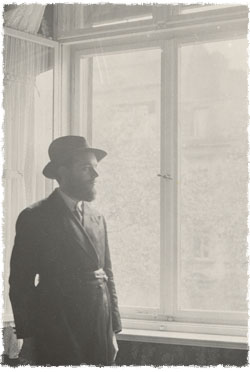
The Rebbe, Rabbi Menachem Mendel Schneerson, of righteous memory (circa late 1920s)
At that point, the Bar-Mitzvah boy’s father—my husband—urged the boy to promise him something, but the Bar-mitzvah boy wasn’t so ready to make that promise.
It was evident on the faces of those coming out of the room—old or young, Torah-observant or non-observant—that they had been weeping. There was an atmosphere that I simply cannot describe. It took many hours before our son gave his father the positive response he asked of him.
Everyone then joined together in spirited dancing, their faces still showing signs of their previous weeping, but now combined with intense joy. They were all transported to a different world.
Our son was a slim boy with a refined face reflecting an inner inspiration—of a caliber rarely encountered.
On 1 Adar I, 5719 (February 9, 1959), Rebbetzin Chana recorded the following in her memoirs:
At a time when we look forward to a good week, and it’s also Rosh Chodesh, particularly of the month of Adar, when “we increase joy,”3 I should write in a cheerful mood.
However, I’m sitting alone at home, not so upbeat. On the 28th of Tevet, I became 79 years old. Thank G‑d that I’ve been able to keep going until now in my present condition, emotional and physical, but it gets more difficult every day.
This week was the bar-mitzvah celebration of a friend’s son. It reminded me of the bar-mitzvah of my older son, long may he live in good health and with success. All the bar-mitzvahs of our sons were celebrated by us in a fine manner. But my older son’s was something special, extraordinary, on a highly sublime level. It was our family’s first personal celebration.
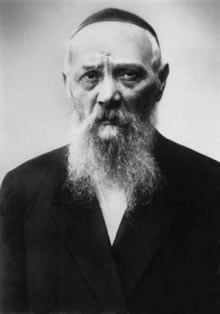
Rabbi Levi Yitzchak Schneerson (1878-1944)
My husband, of blessed memory, was held in high regard. This was despite the initial “birth pangs” of his rabbinic position due to opposition by non-Chasidim and Zionists against Lubavitch, which they considered him to personify and which is why they didn’t want to accept his appointment. But now it was already seven years that we had lived in the city, and our supporters were proud of my husband’s accomplishments, while those opposing had often expressed their remorse. Now both sides had an opportunity to express their feelings.
For our good friends, it was a genuine celebration, expressed in a delightfully friendly closeness which had a delectable feeling, as I remind myself now.
It was held on a Shabbat, and many guests attended. At that time we had a large home, and all its rooms were packed. Because it was so crowded, there was a constant interchange of guests, with some leaving while new ones came to take their place. I had many female guests, and there were also many young people. All these groups included guests from all sorts of background.
I don’t remember exactly when it started, probably around 12:00 noon, after the conclusion of prayers at shul. The men sat in the large hall, while we women were in the large dining room. Of course, the tables were beautifully set with abundant food, for both the men and the women.
Around 3:00-4:00 p.m. we saw some of the male guests, both old and young, emerging with weeping faces. I tried looking inside the main hall to discover the reason for their tears, but it was so crowded in there that I couldn’t see through all the heads.
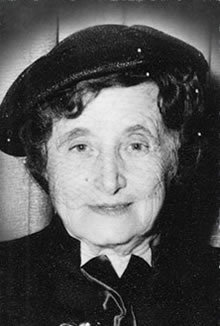
Rebbetzin Chana Schneerson (1880-1964)
When I asked those who had been inside, they told me that the father—my husband—had requested our son (long may he live) to promise him something. I wasn’t inside, so I don’t know the actual course of events. But our son’s reply, apparently, wasn’t immediate. Everyone was amazed by the great character of such a young boy, that he was so guarded and cautious about giving his reply.
I don’t know the details of what actually happened there, but around 6:00-7:00 p.m.—I remember it wasn’t so light any more—the weeping faces I had previously seen became very happy. Now from inside we heard the sound of such joyous dancing and singing, and the joy became so intense that it affected those outside, too. One sensed that the enthusiastic rejoicing held some deep significance, and that both the nature of the request and the one who gave his reply would remain memorable for a long time.
In Di Yiddishe Heim, Kislev, 5724 (p. 5), N. Ben-Yochanan (Nissan Gordon) writes what he heard from the Rebbetzin:
“Concerning the great Bar-Mitzvah celebration held in Yekaterinoslav, the Rebbetzin remembers to this day that, after his speech, which left a deep impression on all the guests, the Bar-Mitzvah boy wept intensely and many guests who witnessed this were prompted to weep, too.
“[The Rebbetzin] heard that her husband had insisted that the Bar-Mitzvah boy give him a certain promise, although she had no idea what it was. She remembers, however, that in the evening, following Shabbat, when the Bar-Mitzvah boy agreed to give his word as his father asked, it was followed by great rejoicing, with dancing until late at night.
“Who knows? Perhaps father and son were already discussing matters pertaining to the future of Chabad-Lubavitch?”
FOOTNOTES
1. That year, 1915, the Rebbe’s birthday, 11 Nissan, fell on Friday, the eve of “Shabbat Hagadol” (the “Great Shabbat,” the Shabbat before Passover).
2. The ceremony marking the conclusion of the Shabbat.
3. Taanit 29a.
© Copyright 2015, all rights reserved.
| Passover Toolkit Sell Your Chametz Online Since it is prohibited to possess chametz on Passover, any chametz left undisposed must be sold to a non-Jew. All such chametz, as well as all chametz utensils that were not thoroughly cleaned, should be stored away. The storage area should be locked or taped shut for the duration of the holiday. Since there are many legal intricacies involved in this sale, a rabbi acts as our agent both to sell the chametz to the non-Jew on the morning before Passover, and also to buy it back the evening after Passover ends. The form on this page may be copied, modified, filled out, printed and submitted to your local rabbi by early morning of April 3, 2015, local time. If you are unable to submit your form to a rabbi in person, you may submit your form online. Jewish law requires that your chametz be sold by the specified deadline for the location in which the owner will be on the day before Passover. Click here to look up this time for your city. One may eat chametz until two seasonal hours before midday on the day before Passover—this year, April 3, 2015. Click here to look up this time for your city. To learn more about about the search and removal of chametz, click here. © Copyright 2015, all rights reserved. Passover Toolkit Order Shmurah Matzah Traditional handmade shmurah matzah is recommended for seder use. Include handmade Shmurah Matzah at your seder table and share this sacred tradition with your friends and family. Handmade shmura matzah is available in many Jewish supermarkets, and are often available for purchase at synagogues and Chabad centers around the world. In case you can’t find Shmurah Matzah locally, we put together several links where you can order Shmurah Matzah online: Matzah Gift Packs - 3 Matzot  Shmurah Matzah Shmurah MatzahIncludes 3 matzot. Options include, matzot baked in Israel and Ukraine. $9 to $12 per pack of 3 Order a 3 Pack  Matzah by the Pound Matzah by the Pound Shmurah Matzah Shmurah MatzahIncludes approximately 7 matzot in color box. Baked in Israel. $22.50 per lb. Quantity:  Whole Wheat Shmurah Matzah Whole Wheat Shmurah Matzah1 lb. 100% whole wheat shmurah matzah. Includes approximately 7 matzot. Baked in USA. $25.00 per lb. Quantity:  Spelt Shmurah Matzah Spelt Shmurah Matzah1 box of 100% spelt shmurah matzah. Includes 6 matzot. Contains 100% certified organic spelt. Baked in USA. $30.00 per box Quantity: © Copyright 2015, all rights reserved. Passover Toolkit Explore Our Passover Megasite 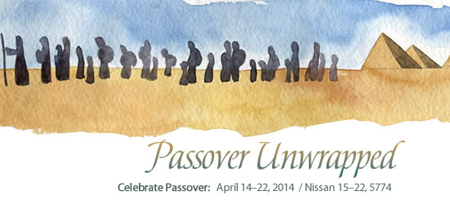 Pesach (Passover) is April 3-11, 2015 Order Matzah | Sell Your Chametz Other Cities | More Options        Quick Links  The Haggadah The Haggadah The Seder The Seder Ma Nishtana Trainer Ma Nishtana Trainer Passover Recipes Passover Recipes Passover Songs Passover Songs Passover Calendar Passover Calendar Greeting Cards Greeting Cards Passover News Passover News Passover Kids Site Passover Kids SitePassover.org in other Languages: Français | Español | Italiano | עברית | Русский | Magyar | Deutsch | Português New Short Video: Let’s Celebrate True Freedom! © Copyright 2015, all rights reserved. |
My Moment with the Rebbe By Chaim Mendelsohn
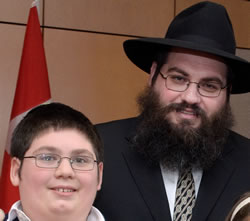
I am standing in line together with tens of thousands of other Jews from all religious backgrounds and affiliations. In the sweltering New York City heat, we wait for over four hours for our moment to stand in front of the Rebbe’s gravesite. To reflect, to say a prayer, to ask for a personal blessing.
As I wait in the long line, I take a few moments to observe the expressions of those waiting along with me. Solemn, serious, intense. Most people utilize their time by reading words of Psalms or studying from other sacred literature. Some wear long beards and black fedora hats identifying them as Chabadniks, others wear the wide felt hats and long side curls of other chassidic groups. There are still others who have clearly donned kipot just for this occasion.He is getting restless Two African American women stand in line, clutching pictures of the Rebbe in their hands as they patiently wait for their moment. There is one thing that unites us all. We are all admirers of the Rebbe. We have all been influenced by his leadership, some directly, some indirectly.
My 11-year-old son is standing next to me. He is getting restless. We have already been waiting in line for over two hours. It takes me back to a time when I was 11 years old. I was also standing in a long line for hours. I too was restless. I was impatiently waiting for my moment with the Rebbe. I would walk by the Rebbe and receive a crisp dollar bill from the Rebbe’s hand. The Rebbe would stare at me with his penetrating eyes. His stare was so intense, it felt as if he was peering right into my soul. He would wish me a blessing for success.
In fact, the Rebbe would spend every Sunday greeting thousands of men, women and children. Jews and non-Jews of all backgrounds and affiliations would come to receive a blessing and a dollar bill, relishing the opportunity to see the Rebbe face-to-face. Chief rabbis, world leaders, senior politicians, the Hollywood elite and Jewish activists would all come seeking inspiration and direction. The impoverished, the heartbroken, widows and orphans would all come for their moment with the Rebbe. All would leave feeling motivated and more empowered to effectively realize their personal potential. To positively influence the lives of others. To selflessly contribute toward a better society.
The dollar was meant to be given to charity. It represented the Rebbe’s philosophy of life, that when two people get together for whatever reason, it should always directly benefit a third individual.
I was lucky to have waited in those long lines many times. I received dollars, coins, honey cake, and various different sacred books of Torah. Every time, I left with the same overwhelming emotion. I was a little boy, but when I passed by the Rebbe, I didn’t feel like a little boy. I felt like I was important, like I had distinct and consequential value. The Rebbe didn’t treat me like a child. His serious eyes begged me to make a difference. His expression was loving yet demanding. I did not want to let him down. I vowed that I would make him proud.
I will never forget the first time I experienced the festival of Simchat Torah with the Rebbe. Hours before the hakafot service, the traditional dancing with the Torah, my father brought me to the Rebbe’s synagogue. My father warned me that the crowd would be enormous and the pushing intense. Tens of thousands of guests would travel from across the globe to spend Simchat Torah in the Rebbe’s court. Despite my father’s warnings, I was completely unprepared for the chaotic scene that I witnessed. It was literally a sea of humanity. Every inch of space was filled with people clamoring to catch a glimpse of the Rebbe dancing with the Torah scroll in his arms. Benches-turned-bleachers were constructed around the walls of the synagogue, like in a stadium, five or six rows high.The Rebbe didn’t treat me like a child
The climax of the evening was when the Rebbe would walk from the front of the synagogue, clutching the Torah in his hand, to the middle of the room, where he would dance on a raised platform. The Rebbe would walk down a narrow path that was separated by two long tables.
My father and I had come early enough to secure a place at one of those tables. As the evening progressed, and the numbers of congregants continued to grow, my father tightly wrapped both his arms around me to make sure I wouldn’t slip out of his grip. The anticipation was mounting. In mere moments, the Rebbe would walk toward the middle of the room. The excitement was so real, so genuine. You could feel it. You could almost touch it.
The Rebbe turned around. He began to walk. The crowd surged, pushing forward, trying to get just a little closer to the Rebbe. I could feel my father losing his grip on me. His embrace weakened. I did my best to push myself backward into my father. It was useless, impossible, a futile exercise. I slipped off the table. Fear overcame me. I could see the Rebbe coming toward me. I had nowhere to go. Time stopped. It felt like an eternity. I started to cry.
Thankfully, someone very strong came to my rescue. He reached over, lifted me in the air, and quickly moved me out of the way. I ended up in the arms of a nice man, who comforted me and positioned me so that I could watch the incredible scene unfold.
The Rebbe danced alone. He walked around to every side of the platform and danced, ensuring that everyone in the room had a chance to capture the experience. It was truly Simchat Torah. The Rebbe exuded simchah, happiness, joy. You were able to sense the Rebbe’s desire to share his simchah with everyone in the room. To lift up everyone in the room.
It is what happened next that had the most impact on me, an 11-year-old boy.
The Rebbe was walking back toward the front of the synagogue. Anyone who was in arms-length of the Rebbe stretched out their arm to be able to touch and kiss the Torah. The Rebbe walked slowly. I wished I could have the chance to kiss the Torah. It was impossible. I was just too far. I clumsily stretched out my arm. Suddenly, the Rebbe stopped. He noticed my outstretched arm. He looked me straight in the eye, with the same penetrating, loving stare I would receive when he handed me a dollar bill. He extended the Torah as far as he could; I stretched out my arm as far as I could. We met. I managed to kiss the Rebbe’s Sefer Torah.I clumsily stretched out my arm
The Rebbe could have just ignored my outstretched arm and longing face. After all, I was only a little kid. I would get over it. But in the Rebbe’s eyes, I was not a young child; I played an integral, crucial part of G‑d’s master plan. I had an important mission. I was no longer an 11-year-boy who was filled with fear and anxiety over being separated from my father. I was now a confident young man, ready to carry my weight.
This was my moment with the Rebbe. A moment that lasts forever.
I often think of my moment. It has carried me forward for the past 20 years. It was the inspiring factor that convinced me to join the Rebbe’s army of shluchim—a group of over 4,000 activists in over 81 countries determined to realize the Rebbe’s dream of bringing goodness, kindness, warmth and light to every corner of the globe. I have encountered many challenges in my years of shlichus, and it has been my moment with the Rebbe that has helped me persevere.
I am finally standing in front of the Rebbe’s gravesite. Through eyes brimming with tears, I read the Rebbe’s name etched in the tombstone. I feel the deep void. I long for the Rebbe’s physical presence, guidance and leadership. I close my eyes. I relive my moment. I reaffirm my pledge to dedicate my life to the ideas and ideals of the Rebbe.
I look down at my son. His face is shining. He is saying his chapter of Psalms. There are no tears in his eyes. This is his moment with the Rebbe.
I know that he is as determined as I am to fulfill his mission. He no longer feels like he is an 11-year-old kid. He feels proud, empowered, confident. He recognizes that he is a valuable component of the Rebbe’s vision.
Rabbi Chaim Mendelsohn is the Spiritual Leader at Chabad of Centrepointe, a vibrant synagogue and community centre in Ottawa. He also serves as the Director of Public Affairs for the Canadian Federation of Chabad Lubavitch. The CFCL represents over one hundred non for profit schools, camps, synagogues, community centres and social centres across Canada. He served for three years as a reserve chaplain in the Canadian Armed Forces. He was the first Jewish chaplain to serve since the Second World War and was instrumental in helping coordinate the Military’s first Jewish regular force chaplain. He hosts a weekly radio show on Ottawa’s CKCU FM. He is married to Bassy Mendelsohn and is the proud father of six children, four girls and two boys.
© Copyright 2015, all rights reserved.
11 Nissan
When the Music Stops and the Lights Go Out by Chava’le Mishulovin

I’m hiking up Boulder, Colorado’s famous Flatirons, dripping with sweat and nearly out of breath. I hope to beat my previous record by even just a few minutes, so I keep pushing myself to jog just a bit faster. I’m nearing the top. I’m aching. I force myself to keep going. And then finally, my pains take second place to the triumphant feeling that overtakes me when the Royal Arch finally comes into view. I spend a few minutes on the peak, breathing deeply, enjoying my well-earned break. The view is magnificent. I feel completely content.I hope to beat my previous record
Abruptly, I stick my headphones in my ears, jump down from my high rock, and begin running down the rocky trail. Euphoria races with me, zigzagging through my veins. The music propels me, and each high note elicits a more daring leap.
Earlier I had been a beggar, pleading with myself for rest and greedily gulping air when the folks ahead of me slowed; now, I am king. Other hikers scramble to the side as they hear my pounding footsteps. I don’t listen to their conversations, I don’t notice their gear, I don’t even feel the ground. Endorphins are rushing out to cheer me on and lift me in the air.
I’m flying and nothing can stop me. I’m flying and flying and WOAH—!
I stop. I stop because my music stops.
Not a few-seconds-in-between-songs-that-you-barely-notice-because-the previous-notes-still-linger kind of stop, but a music-is-absolutely-over-because-the-battery-is-absolutely-dead kind of stop.
I examine the lifeless piece of metal. Sigh. Faced with no other option, I pick up my pace to continue my exuberant run. But alas, with no music there is no exuberance and there is no run. I just can't seem to propel myself forward without the music fueling me.
I slump my way downhill, and it suddenly dawned on me how foolish I had been. Just moments before, I had taken incredible leaps and bounds, but now, without my music player, I am starkly aware that all my energy came from my music, and without it I've got nothing to keep me going. All my jumps and spurts and dives were not me; they were just my music. I was living—and running—a lie.
Oh c'mon! I think to myself. That's ridiculous. Don't be so hard on yourself. You can still do your hike; the only difference is that it's just not as fun and easy and you can't run as fast and happily and—aaaahhh, why did I ever think that this hike would be a good idea?!
The Baal Shem Tov taught that everything we see and hear should be a lesson in our service of our Creator, so I reflect upon other “musics” that keep me going in my life.
When I prayed in the Ma’arat Hamachpelah for the first time, the words of the Shemoneh Esrei prayer had never seemed so bold and so precise: "The G‑d of Abraham, the G‑d of Isaac, the G‑d of Jacob." I'm HERE!!! Not only am I praying the prayers that our forefathers composed, but I am actually standing right here where they are buried!
I was electrified. I felt all of history pouring into my mind, deep into my soul, and then out through my lips. I was one. I was here. This was it.
The drama of that moment buoyed my concentration during prayer for a good few weeks and enabled me to maintain the appropriate awe of communicating with the King of Kings. But then it fizzled. Leaving Hebron, other scenes were outside my windows in Tel Aviv and Sweden and California, and other thoughts accompanied my words of prayer. Only when I'd gaze upon my posters and personal photos of the historic Cave would I feel myself transported and enveloped by our ancestors, and their words would take over mine. So I began to develop a little game: As soon as I felt my prayers were wanting, I'd hit "play" on the “Machpelah Soundtrack” and voilà, I was back on the field.
That was the music for my prayer.
And then there was the time I had to bravely face Shabbat without its usual accompanying music.
"Plantar fasciitis," Dr. Goldstein had proclaimed.
My blank look invited further explanation.
"You'll never get into the Arch of the Year Club."
I laughed nervously.
The doctor carried on talking, explaining that my condition of plantar fasciitis meant that there was an inflammation of the thick tissue that connects my heel bone to my toes and creates the arch of my foot, namely the plantar fascia. He prescribed custom-made orthotics and told me to schedule an appointment for the casting. He wrote down which sneakers would be best to wear, even before the orthotics would be ready, and I hurriedly limped off to the shoe store. I handed my note to a salesperson, who led me to the Dorky Shoe Section and pointed out the two pairs that the doctor recommended. I tried them both on, gasped in delight at the comfort they provided, and chose the better-fitting one, gratified, if not a bit dazed, that I suddenly could walk on two solid feet again."Plantar fasciitis," the doctor proclaimed
With only a few hours until the onset of the holy Shabbat, I quickly drove home, my mind reeling. I had gone into the office thinking that he'd tell me I was imagining the pain, and the next thing I knew, I was thrown into a fierce world of fascia and frighteningly unfashionable footwear.
Shabbat.
Holy, pure, majestic, regal.
Shabbat.
Exquisite finery, delectable cuisine, sparkling quarters and . . . chunky white sneakers.
My stomach in knots, I felt ill. I wanted to dress in a regal way to honor the Shabbat Queen, but I couldn’t take any steps without my sneakers. I was torn. I couldn’t walk without them, but I felt too embarrassed to walk out with them. Tears sprang to my eyes. I paced. I heard the guests arriving, bubbling with joy and friendship. I felt horrid. With my weekday appearance, Shabbat had lost its glow. My outfit was a joke as soon as the sneakers came into view.
I stayed in my room for hours. And the next Shabbat as well.
During the week, I learned how to somewhat disguise the very unfeminine and awkward sneakers, but when Shabbat would roll around, I'd be stuck in misery. How could I feel like it was Shabbat when I was dressed for a soccer game?!
But wait, was sitting in pain and self-pity a more fitting offering for the Shabbat Queen?
Was it possible to honor Shabbat even when the festive, elegant and respectful “music” that had regularly accompanied the Shabbat day was silenced?
Yes. Because I could create new music. The glory wouldn’t come from my clothing, but from my inner peace, and I would walk to its beat, head held high.
That Shabbat, I’m pretty sure I saw the Queen nod smilingly at my gift offered from the depths of my soul rather than merely the fabric on my sole.
When the music stops, I can create my own.
This past Chanukah, that ability was uncovered to a greater degree.
Chanukah is a pretty easy holiday, compared to the fasting and praying for nearly 26 hours of Yom Kippur, or the building of and eating in vulnerable sukkah huts for a week, or preparing for and celebrating an eight-day chometz-free Pesach. All we have to do is kindle the menorah in our homes for eight nights. Ok, and maybe taste a jelly doughnut here and there. Somehow, though, every year I manage to schedule at least one trip during the festival, and this year I had to move about a few times, which made things a bit complicated. Transporting my oily equipment time and time again and finding the most kosher place to light my menorah proved to be slightly frustrating, and I envied the simplicity of everyone else's celebrations.
One night, I think it was the sixth, I sat there brooding about my plight. “Everywhere I go, I have to shlep these lights with me.” Whoosh! A flash of realization suddenly illuminated my words.Everywhere I go, I take lights with me. That's fantastic, not burdensome! Every darkness I encounter sees me equipped with effective weapons of light, effortlessly claiming territory. This Chanukah taught me that I have a light inside my soul, so when the lights go out on the outside, I can and should light up my surroundings from the inside.
After all, who asks for light during the day? Who seeks music during a concert?
It's when the music stops and the lights go out that we're called on to dance and to shine.
It's been nearly 6,000 years since the creation of the world. We've had brighter periods and darker periods, waxing and waning like the moon, but we've yet to experience an ultimate and eternal light.
Today is the eleventh day of the Hebrew month of Nissan. On this day, in 1902, the rhythm of the world was dramatically altered with the birth of Rabbi Menachem Mendel Schneerson in the Ukrainian town of Nikolayev. At the age of 48, Rabbi Menachem Mendel officially accepted the mantle of Chabad Chassidic leadership with the call to his followers to bring the G‑dly Shechinah light down to our world for infinity, ushering in the final redemption.Everywhere I go, I take lights with me
A grand command, but with his constant encouragement and guidance, his disciples set forth at full force and brought back stories of success to their beloved Rebbe, who would appreciate their results and immediately challenge them to double them. And they would.
So what happened when the seventh and final Rebbe of Chabad Lubavitch passed on to the World of Truth?
"Oh, they'll never last," people confidently predicted of the chassidic group. "Shame," they lamented, "they were a pretty solid movement, but now that their leader is not here to lead them, they'll fall apart."
But the Chabad chassidim still heard the songs of the Rebbe reverberating loudly in their ears, and they carried on living and spreading his message of preparing the world for the complete and ultimate redemption. Years passed. Two full decades later, and the young children of then are now blazing ahead as if they were “front-row seat-ers” at the Rebbe’s empowering gatherings of divine inspiration and mission, but in reality, most were never even there.
Their memories are vague at best, and their connection seems to be second hand, so where does their drive come from? What is setting the tone for their storming the world with goodness and passion? And how do their elders still hear a voice that has been silent for 20 years?
These extraordinary men, women and children have created their own music.
They can't rely on physical interactions with their Rebbe; no more can they be urged on by a literal swing of the hand, an encouraging remark made face-to-face, or even a focused gaze from across a packed room. No more can they survive on the fuel of years past, so the Chabad chassidim have dug within themselves and found a faith and focus not dependent on the physical presence of their leader. The truth he led them to years ago is now firmly their own, and now each moves to the unique song he has created. It is their individual yet collective music that propels their outstanding growth and success. And it is this harmony that the world hears and is causing them to slowly but surely sing similar tunes of determined outreach and loving conquest.
Recently, jogging down Los Angeles's Runyon Canyon, I saw a girl wearing a T-shirt that read, "Feel The Music." I smiled, my mind wandering in anticipation of the day when the lights will be so bright and the music will be so resounding that more than seeing and hearing, we will actually feel the unifying and redemptive music of the divine light.
Chava’le Mishulovin dreams of settling peacefully in Hebron. Her odyssey takes her around the world, where she attempts to unearth the sparks of G‑dliness and unleash the languages of laughter in her path.
© Copyright 2015, all rights reserved.
Other Stuff
10 Diverse Foods that Say "Passover"
G‑d’s vision for Passover cuisine is simple: we are to eat the roasted Paschal lamb with matzah and bitter herbs, and then for the next seven days we are to avoid chametz (leaven). And so, over the years diverse Jewish communities have developed their own Passover cuisines, introducing foods that have become uniquely associated with the holiday. Here is our list of favorites.
1. Egg Lokshen
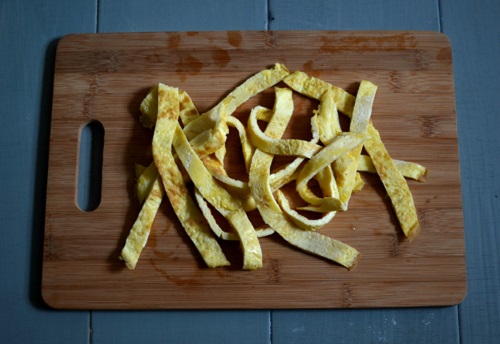
Since flour-base noodles are out, many people make thin crepe-like pancakes out of eggs and potato starch, which they then roll up and cut into strips, forming kosher-for-Passover noodles (“lokshen” in Yiddish) which taste marvelous in chicken soup. (Note: they only last a few days in the refrigerator before becoming mealy. Also note that the thinner you make them the better they taste.)
2. Schmaltz
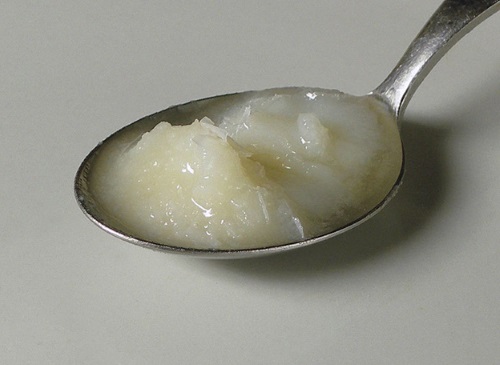
(Photo: Rainer Zenz)
Yes, rendered chicken fat. Many chassidic communities do not used processed foods during Passover as an extra precaution against chametz. And so some people do their cooking—and even salad dressing—with schmaltz, chicken fat which is cooked over a low heat until it melts. Schmaltz has a creamy consistency when served at room temperature.
3. Gribenes
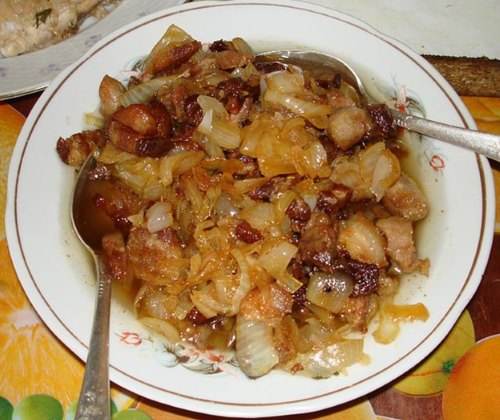
One delicious but very unhealthy Passover treat is gribenes, crispy onions and chicken skins that have been fried in schmaltz.
4. Soft Matzah
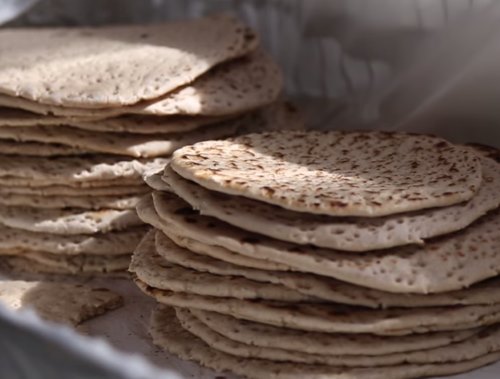
(Image: Mashiach Kelaty)
Almost all of us are familiar with the crunchy matzah that looks and tastes like cardboard and lasts almost forever. Once upon a time, it was common to bake fresh matzahs that were soft and thick. For a number of reasons, which you can read here, this kind of matzah was phased out in almost all Jewish communities hundreds of years ago. However, some communities still bake soft matzah the old-fashioned way. The matzahs pictured above were baked by Sephardic Jews in London, England.
5. Macaroons
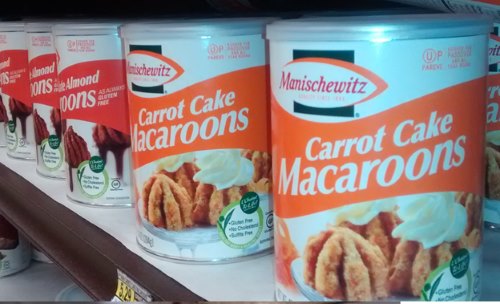
Yep, you knew that macaroons would be on this list somewhere. Our informal polling shows that coconut-based macaroons are like cilantro. Some people love them, and the rest of us are left scratching our heads trying to figure out why. Yet, for whatever reason, Manischewitz has made a killing convincing Jews all over that these mushy excuses for cookies are part of the Passover experience.
6. Thick Seder Wine
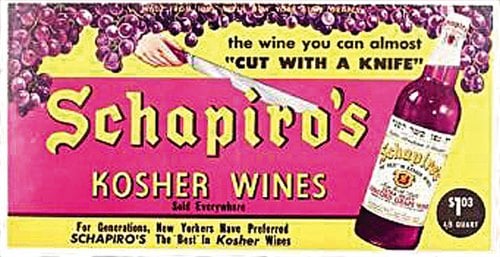
Talking of Manischewitz, there is another persistent idea out there that Seder wine needs to be gloopy sweet stuff that comes in a square bottle and tastes like cough syrup. At one time, this kind of wine was so ingrained as a Jewish wine preference that Schapiro’s Wine advertised (in Yiddish) that their wine was so thick you could almost cut it with a knife! Thankfully, there are hundreds of high-quality kosher wines out there, but we respect the traditionalists who like the old thick stuff.
7. Borscht

Back in the old country, there were very few fresh veggies by winter's end. So when grain was eliminated from the menu on Passover, potatoes, beets, and other long-lasting produce from the cold cellar became Passover staples. Nothing quite says Passover like a glass of deep purple borscht.
8. Sugar Water
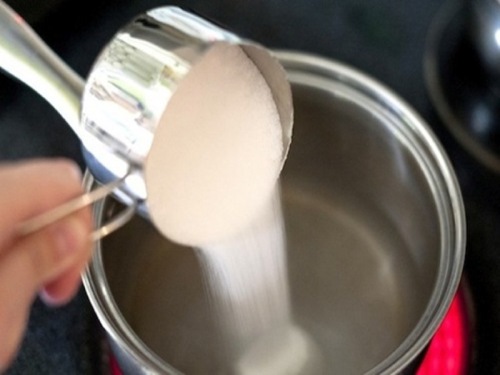
There is an interesting rule in Jewish law whereby a small particle of chametz can be rendered null if it is in an overwhelmingly large mixture of non-chametz before Passover, but once the holiday begins, even the smallest speck of chametz is prohibited. And so, there are some who like to make any food that has even the slightest possibility of containing chametz before Passover as an added precaution. Because of this, many people prepare "sugar water" (known to foodies as simple syrup) before the onset of the holiday, which they then use instead of regular sugar over Passover.
9. No Matzah Balls!

You're probably wondering why there is no matzah ball in the bowl of chicken soup pictured here. After all, isn't it Passover? You may be surprised to learn that many Ashkenazic Jews (particularly chassidim) are particular not to let their matzah come in contact with water on Passover, lest there be a speck of flour trapped in the dough that could still be "activated" and rise.This means no matzah balls. But there is an important exception. For reasons you can read about here, we do use wetted matzah, known as gebrokts, on the eighth day of Passover (celebrated only in the Diaspora). So the matzah ball does finally roll out of the kitchen, but a week later than expected.
10. Mimounah
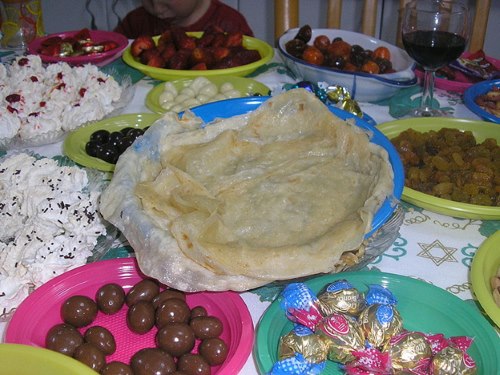
Just because Passover has ended doesn't mean that the food parade needs to come to a halt. Many Moroccan Jews have the custom of hosting family and friends for a post-Passover feast known as Mimounah. A traditional food at this feast is a fried pancake known as moufleta.
© Copyright 2015, all rights reserved.
Other Stuff
When You Crash, 150 People Crash with You by Mendy Kaminker

The Germanwings crash over the Alps–which now seems to be all but confirmed as suicide–is one of the most disturbing air incidents yet. We’ve all heard about terror attacks, hijackings, malfunctioning aircraft and planes even downed by missiles. But this?
The airplane was in stellar shape. There was no terror organization involved, aiming to sow fear in people’s heart. No one could have counted on one very unfortunate individual who wanted to end his life this way.
Still, why take so many down with him?
We might never know the answer, and whatever we do discover will never comfort the grieving families of all those victims.
The question did, however, bring other thoughts to mind.
You might have heard the famous question: Why do people do so much research before going into surgery—comparing doctors, hospitals, ratings and success rates—yet they board a plane without ever checking on the pilot?
The answer is simple.
The surgeon operates only on you, but he himself can stay disconnected; there’s no inherent risk for him. But the pilot is not only flying your plane. He’s flying his plane, too, and if something happens to you, it will happen to him. So you trust him to do all he can to arrive safely, knowing his end goal matches that of the passengers.
This pilot, however, broke that trust. And so he crashed together with 150 people.
As with everything in life, there is a lesson in this. Whether we recognize it or not, we are all pilots. We all have circles of influence, people who are directly affected by us.
And when we crash, they crash right along with us. If we are negative, if we are not happy, if we are not fulfilling the mission G‑d had given us, then they suffer as well.
So if we are going through a difficult time, inspirationally or emotionally, we have a responsibility to do all we can to get ourselves out of it—not only for our own sake, but for the sake of those who rely on us.
One more thing (which is actually the thing): When we fly, they fly with us. When we soar, they are uplifted. When we become better, happier, more Divine people, they are right there, impacted by us and all we do.
There are real choices to be made in life, all the time, easy and difficult. Which ones will you make?
Rabbi Mendy Kaminker is the editor of Beit Chabad, the Hebrew edition of Chabad.org.
© Copyright 2015, all rights reserved.
Question
Was Matzah Always Hard and Thin? by Yehuda Shurpin
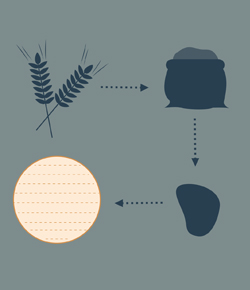
Question:
I’ve heard people say that matzah used to be soft—something like pita or laffa—and that it was only when it began to be mass-produced that it become this hard, cracker-like stuff. Is this true? And if it is, can I use pita for my matzah?
Answer:
Jews have been debating the thickness of their matzah for thousands of years. The Talmud records a debate between the students of Shamai and Hillel regarding whether one can bake matzah on Passover that is up to a handbreadth thick.1 2 Jewish law follows the school of Hillel, which allows the thicker matzah; however, all halachic authorities agree that a thickness of a handbreadth or more is not acceptable.3
In addition to the fact that such thick matzah is susceptible to becoming chametz because of the baking time, there is another problem. When the Torah commands us to eat matzah on the Seder night,4 it uses the term “lechem oni,” “poor man’s bread.” And thick bread is not considered poor man’s bread according to Jewish law.5
However, when we consider that the above discussion is about a matzah that, although under a handbreadth, is still several inches thick, it’s clear that matzah used to be baked with a higher ratio of water, making it a lot softer than our crispy matzah today. There is even an incident discussed in the Talmud where a moldy loaf is found on Passover, and one can’t tell whether it’s bread or matzah. Our cracker-like matzah would be easy to identify—and I’ve yet to see it go moldy, even after sitting in storage for a year.6 7
And yet, while some Jews of Middle Eastern descent still make their matzahs thick and soft, the overwhelming majority of matzahs today are hard and thick. What happened?
Matzah Started Thinning Out
By the 17th century, the widespread custom was to make matzah thinner than the handbreadth mentioned in the Talmud. Rabbi Hillel ben Naphtali Tzvi (1615-1690), known for his legal work Beit Hillel, writes that that the custom was to make matzah thinner than normal bread and as thick as an etzbah (finger).8
There seem to be two reasons for the thinning of matzah over the years:
1) Although the students of Hillel ruled that matzah could be up to a handbreadth thick, there is in fact another opinion in the Talmud, that of Rabbi Yosef, which defines a “thick matzah” simply as thicker or larger bread.
Rabbi Yom Tov ben Avraham Asevilli (1250-1330), known as the Ritva, writes that since no actual measurement was given in the Talmud in regards to Rabbi Yosef’s opinion, one should be careful that the matzah used for the Seder not be thick at all. Accordingly, he cites the custom to use only “thin matzah” for the Seder.9
2) Another issue is that if one were to use the same ovens for thin matzah and for soft, thick matzah, the hot oven would quickly heat the outside, making it look well baked but leaving it unbaked, and possibly chametz, on the inside.10
Accordingly, Rabbi Schneur Zalman of Liadi (1745-1812) writes in his Shulchan Aruch that while in theory thick matzahs are kosher, one must inspect them carefully to ascertain that they are baked through. He concludes that one should try to use only thin matzah.11
Matzah Becomes Drier and Thinner
Although we find that by the 17th century matzah had thinned out to about the thickness of a finger, it was still soft, and so would not stay fresh for more than a few days. As a result, and in light of thehalachic concerns around baking matzah on Passover itself (if you are not extremely careful, you could end up with chametz!), the custom developed to start making matzah with a smaller ratio of water to flour, resulting in harder matzah that would not go stale.
However, this longer-lasting matzah was harder and thicker, and therefore it was more difficult to knead the dough. This raised a new concern. If it is difficult to knead and roll the dough, there may be some flour that remains unmixed inside the dough. At the same time, since the matzah was hard, it seemed more likely that people would want to eat it with water to soften it. However, doing this could potentially result in unbaked flour mixing with water, resulting in chametz.
Although some rabbis dismissed this concern out of hand,12 others felt that this was indeed something that one should be careful about.13
It is possible that it was as a result of this concern that matzah was made even thinner. Additionally, matzah-bakers started spending more time kneading the matzah, so there was less concern about unmixed flour in the matzah or that one might eat it with water.14
Thus, by the end of the 18th century, our thin cracker-like matzah was born and quickly gained popularity.
Modern Day Concerns with Wet Matzah
Although one potential problem with eating wet matzah (or “gebrokts”) seems to have been alleviated by kneading the dough better and making thinner matzahs, many, including Chabad, are still careful not to let their matzah get wet.
Rabbi Schneur Zalman of Liadi discusses the issue of wet matzah in a famous responsa. In the process of baking the hard matzah we eat today, it has become customary to be extra careful and rush through kneading and rolling the dough in order to finish making the matzah within the allotted 18 minutes. This leads to the dough not being kneaded as well as it used to be, and it is therefore possible to find tiny flecks of flour left on the surface of our hard matzah. Because of this, one should be careful not to get the matzah wet, thus avoiding any chance of this flour becoming chametz.15
In conclusion, it is indeed true that we used to have softer and thicker matzah. The reason that matzah became harder and thinner throughout the years is due to legitimate halachic concerns that arose well before the advent of mass matzah production. That being the case, while in theory you could still have softer and thicker matzah today, in practice, unless you are really an expert in the process of making these matzahs, you may end up with what looks like matzah on the outside, but is actually chametz on the inside.16
For more on the issue of wet matzah, see Gebrokts - Wetted Matzah.
Rabbi Yehuda Shurpin responds to questions for Chabad.org's Ask the Rabbi service.
FOOTNOTES
1. Talmud Pesachim 36b-37a. See Rashi ad loc.
2. Approx 3.15 inches according to Rabbi Chaim Noah.
3. Shulchan Aruch Orech Chaim 460:4.
4. In addition to not baking extra thick matzah on Passover itself, the Code of Jewish Law rules that the matzah used for the Seder should also not be more than a handbreadth thick. See Shulchan Aruch Orech Chaim 460:5.
5. Kol Bo, Siman 48, Levush Orech Chaim 475:7 citing the Ravad.
6. See Talmud Pesachim 7a and Mishnah Berurah 446:12.
7. Some point to korech—the sandwich made from matzah with a bitter herb inside that we make during the Seder—as evidence that matzah used to be soft. Korech literally means something rolled up—like a wrap. However, although some do explain that the word korech refers to wrapping the herbs in the matzah (Aruch Hashulchan 475:7; Kitzur Shulchan Aruch 119:7) , others explain it to mean wrapping the bitter herbs around the matzah. Thus, korech would not be evidence of soft matzah. (See Rabbeinu Chananel Pesachim 115a; Sefer Hachinuch, Positive Mitzvah 21) .
8. Beit Hillel on Shulchan Aruch Yoreh Deah 97. Cited by the Be’er Haitiv in Shulchan Aruch Orech Chaim 460:6.
9. Ritvah on Talmud Pesachim 36b.
10. See responsa of Chatam Sofer, Orech Chaim 121.
11. Shulchan Aruch HaRav 460:10.
12. Sheilat Yaavetz 2:68.
13. See Shaarei Teshuvah on Shulchan Aruch Orech Chaim 460.
14. See Shaarei Teshuvah, ibid.
15. Responsa 6.
16. This article is based partially on Rabbi Boruch Obelander’s article תולדות השתכללות המצות ואפייתה ובעיית ה'שרויה', Haoros U’biurim, Oholei Torah, Behar Bechukotai 5766.
© Copyright 2015, all rights reserved.
Question
What Is a Maamar? More than just a teaching by Chabad.org Staff
A maamar means something said, from the word amar, which means “to say.” But in Chabad, a maamar is no ordinary statement. The saying of a maamar carries unique significance. In fact, it is in delivering an original maamar to his chassidim that the role of a rebbe is most essentially epitomized.
Chassidim stand when a rebbe says a maamar, because they understand that he is drawing a new light into the world, a new vision for each of them as individuals and for the world as a whole. For generations to come they will study the maamar carefully, striving to comprehend it as much as possible, to repeat it and explain it in their own words, to integrate it into their worldview and into the way they live, and to illuminate all reality with its vision.
But what makes a maamar so unique? What are its characteristics? How is it to be approached, understood and applied?
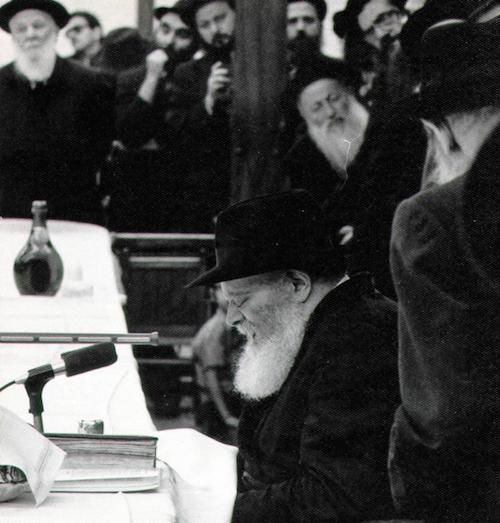
When a maamar is spoken, a new light is entering the world.
On Tuesday, March 31, at 8 PM EDT, Tzvi Freeman will be teaching a live interactive class broadcast on Chabad.org on the maamar “When Your Child Will Ask” delivered before Passover in the year 5738 (1978 in the secular calendar). This is a classic maamar by the Rebbe, Rabbi Menachem M. Schneerson, of righteous memory, related to the question of the wise child of the Haggadah. The class A maamar is an inspired and uniquely authoritative teaching delivered by a chassidic rebbe to his disciples.is being given in honor of the Rebbe’s birthday, 11 Nissan.
Chabad.org is also featuring a new article by Eli Rubin, Intimacy in the Place of Otherness, which discusses the centrality and impact of the Midrashic orientation of chassidic maamarim, based in part on the maamar that is the subject of the online class. In a recent conversation Yaakov Ort, a senior editor at Chabad.org, discussed the question “What is a maamar?” with Rabbis Freeman and Rubin.
Yaakov Ort:

Most people who know about Chabad know that there are teachings that we refer to as maamarim, but most don’t understand exactly what a maamar is. Do maamarim have a common purpose that sets them apart from other forms of teaching? What makes them different than other forms of rabbinic discourse?
Eli Rubin: First and foremost, a maamar is an inspired and uniquely authoritative teaching delivered by a chassidic rebbe to his disciples.
Eli Rubin: First and foremost, a maamar is an inspired and uniquely authoritative teaching delivered by a chassidic rebbe to his disciples.

I say delivered, because in the world of Chabad a maamar is not viewed as a personal composition, as a product of the Rebbe’s own mind, but as a visionary revelation from on high. This is also why I used the word authoritative. In Chabad parlance, such teachings are referred to as divrei elokim chayim (or by the acronym dach): words of the living G‑d. The rebbe is the conduit through which G‑d’s word flows. And the ultimate purpose of these teachingsThe ultimate purpose of these teachings is to make G‑d’s most intimate thoughts openly accessible to everyone.is to make G‑d’s most intimate thoughts openly accessible to everyone.
In the Tanya, the foundational work of Chabad Chassidism, R. Schneur Zalman of Liadi wrote that in each generation there are “wise men, the visionaries of the community,” and that their role is to teach the people knowledge of G‑d so that they may serve G‑d with a complete heart (Tanya, chapter 42). In Chabad, the delivery of a maamar is not seen as just another commentary, another interpretation of the Torah. The delivery of an original maamar is the quintessential embodiment of all that it means to be a Chabad rebbe. It is the moment when the Moses of our time transmits an authoritative communication of divine wisdom which is uniquely relevant to our generation.
The weighty significance of such an occasion was palpable. Before a maamar was delivered, the gathered chassidim would sing a solemn, stirring melody and rise to their feet, preparing themselves spiritually and cognitively for a new influx of divine revelation. Whenever the Rebbe spoke in public, his tone and bearing were usually animated, his eyes open and alert. But when he delivered a maamar, his eyes were closed and his bearing took on an aura of motionless submission, as though the Rebbe was himself soaking up the words issuing in a soft sing-song from his mouth.
In this video you get a sense of the atmosphere when the Rebbe said a maamar:
Tzvi Freeman: Since we’re talking within the context of Chabad, before we can understand what a maamar is, we have to discuss what Chabad is about.
Chabad is an approach to the central teaching of the chassidic movement: that every Jew can serve G‑d with love and joy. Rabbi Schneur Zalman of Liadi realized that you can’t love something you’ve never thought about, and that includes loving G‑d. But that creates a problem, because when it comes to G‑d, as the Zohar says, “no thought can grasp Him at all.” So the task then became, You can’t love something you’ve never thought about, and that includes loving G‑d.how do you think about a G‑d that cannot be understood?
Eli deals with much of this in his essay. I would add that part of the solution is the use of metaphor from the human psyche. Love, wisdom, desire, creativity, etc.—these are also things of which we have no real understanding. Yet we experience them firsthand, so it’s possible for us to ponder them. By borrowing them as metaphors for G‑d’s act of creation and His relationship to us, Rabbi Schneur Zalman rendered G‑d ponderable without compromising any of the mystery, awe and wonder.
Another part of the solution is the maamar. The maamar may be called a guided meditation, but one that really taxes the mind, immersing it deeper and yet deeper into the mysteries of the Torah, the soul, existence, the divine energy that sustains existence, and the Creator Himself.
It’s not enough to study a maamar many times over in depth, critically and analytically. That’s only the beginning. The real point is to think it through for extended periods of time, especially before morning prayers. That’s when it truly becomes a maamar.
But, as I said, the maamar is a means of applying your mind to a G‑d whom your mind cannot contain. That’s a precarious balancing act. On the one hand, you have to put aside your own perceptions and preconceptions and stick to understanding, “What is the maamar saying?” On the other hand, it’s crucial that you engage every facet of your mind, including all the creativity you can muster, inIf you give it everything you’ve got, a maamar lifts you up and out of the mundane into a more inspired form of living.attempting to bring its message closer to your own personal understanding, to make it more tangible and real.
The goal of all this meditation is a kind of cognitive reframing—you end up seeing the world differently and feeling differently about it. If you give it everything you’ve got, a maamar lifts you up and out of the mundane into a more inspired form of living. Your times of prayer and Torah study come alive, and you feel a greater joy in your mitzvahs. You begin to live in a whole different world—the world of the maamar.
Yaakov:
In the Tanya, the foundational work of Chabad Chassidism, R. Schneur Zalman of Liadi wrote that in each generation there are “wise men, the visionaries of the community,” and that their role is to teach the people knowledge of G‑d so that they may serve G‑d with a complete heart (Tanya, chapter 42). In Chabad, the delivery of a maamar is not seen as just another commentary, another interpretation of the Torah. The delivery of an original maamar is the quintessential embodiment of all that it means to be a Chabad rebbe. It is the moment when the Moses of our time transmits an authoritative communication of divine wisdom which is uniquely relevant to our generation.
The weighty significance of such an occasion was palpable. Before a maamar was delivered, the gathered chassidim would sing a solemn, stirring melody and rise to their feet, preparing themselves spiritually and cognitively for a new influx of divine revelation. Whenever the Rebbe spoke in public, his tone and bearing were usually animated, his eyes open and alert. But when he delivered a maamar, his eyes were closed and his bearing took on an aura of motionless submission, as though the Rebbe was himself soaking up the words issuing in a soft sing-song from his mouth.
In this video you get a sense of the atmosphere when the Rebbe said a maamar:
Tzvi Freeman: Since we’re talking within the context of Chabad, before we can understand what a maamar is, we have to discuss what Chabad is about.

Chabad is an approach to the central teaching of the chassidic movement: that every Jew can serve G‑d with love and joy. Rabbi Schneur Zalman of Liadi realized that you can’t love something you’ve never thought about, and that includes loving G‑d. But that creates a problem, because when it comes to G‑d, as the Zohar says, “no thought can grasp Him at all.” So the task then became, You can’t love something you’ve never thought about, and that includes loving G‑d.how do you think about a G‑d that cannot be understood?
Eli deals with much of this in his essay. I would add that part of the solution is the use of metaphor from the human psyche. Love, wisdom, desire, creativity, etc.—these are also things of which we have no real understanding. Yet we experience them firsthand, so it’s possible for us to ponder them. By borrowing them as metaphors for G‑d’s act of creation and His relationship to us, Rabbi Schneur Zalman rendered G‑d ponderable without compromising any of the mystery, awe and wonder.
Another part of the solution is the maamar. The maamar may be called a guided meditation, but one that really taxes the mind, immersing it deeper and yet deeper into the mysteries of the Torah, the soul, existence, the divine energy that sustains existence, and the Creator Himself.
It’s not enough to study a maamar many times over in depth, critically and analytically. That’s only the beginning. The real point is to think it through for extended periods of time, especially before morning prayers. That’s when it truly becomes a maamar.
But, as I said, the maamar is a means of applying your mind to a G‑d whom your mind cannot contain. That’s a precarious balancing act. On the one hand, you have to put aside your own perceptions and preconceptions and stick to understanding, “What is the maamar saying?” On the other hand, it’s crucial that you engage every facet of your mind, including all the creativity you can muster, inIf you give it everything you’ve got, a maamar lifts you up and out of the mundane into a more inspired form of living.attempting to bring its message closer to your own personal understanding, to make it more tangible and real.
The goal of all this meditation is a kind of cognitive reframing—you end up seeing the world differently and feeling differently about it. If you give it everything you’ve got, a maamar lifts you up and out of the mundane into a more inspired form of living. Your times of prayer and Torah study come alive, and you feel a greater joy in your mitzvahs. You begin to live in a whole different world—the world of the maamar.
Yaakov:

What does the world of the maamar look like? Is there a common structure and content?
Eli: Over the generations, each of the rebbes developed his own style and built on the teachings of his predecessors.
Eli: Over the generations, each of the rebbes developed his own style and built on the teachings of his predecessors.

But there are some axiomatic characteristics that carry through all the way. The first, as I mentioned above, is the the visionary authority that maamarim carry. The second is the theme of unity: the unity of G‑d, the unity of the Torah, the unity of the Jewish people, and ultimately the unity of all things.
At the outset, a maamar is usually presented as a commentary to a verse from the Tanach, or to a statement made by the Talmudic sages. Yet the purpose of the maamar is not to decipher the literal meaning of the source, but rather to creatively unearth and reveal new meaning, relevance, insight and inspiration. In a similar way, a maamar will usually invoke and explain Kabbalistic motifs and concepts, drawing on the Zohar and on the teachings of the Arizal. Yet the purpose of such invocations is not to offer scholarly interpretations of esoteric ideas, Each of the rebbes developed his own style . . . But there are some axiomatic characteristics that carry through all the way.but rather to teach us how to apply these ideas in our own service of G‑d.
As I argue in my article, the general characteristics of a chassidic maamar revive the style and orientation exhibited in Midrashic texts, which are the original wellspring from which all streams of Jewish thought and mysticism flow. The hallmark of both Midrash and the maamar is a sense of axiomatic faith, a sense that is both intimate and elusive, and which can be expressed only through the kind of open-minded wonder that draws on all the cognitive and imaginative avenues of the human mind and heart.
Tzvi: Understanding the structure of a maamar helps in understanding the maamar itself.
At the outset, a maamar is usually presented as a commentary to a verse from the Tanach, or to a statement made by the Talmudic sages. Yet the purpose of the maamar is not to decipher the literal meaning of the source, but rather to creatively unearth and reveal new meaning, relevance, insight and inspiration. In a similar way, a maamar will usually invoke and explain Kabbalistic motifs and concepts, drawing on the Zohar and on the teachings of the Arizal. Yet the purpose of such invocations is not to offer scholarly interpretations of esoteric ideas, Each of the rebbes developed his own style . . . But there are some axiomatic characteristics that carry through all the way.but rather to teach us how to apply these ideas in our own service of G‑d.
As I argue in my article, the general characteristics of a chassidic maamar revive the style and orientation exhibited in Midrashic texts, which are the original wellspring from which all streams of Jewish thought and mysticism flow. The hallmark of both Midrash and the maamar is a sense of axiomatic faith, a sense that is both intimate and elusive, and which can be expressed only through the kind of open-minded wonder that draws on all the cognitive and imaginative avenues of the human mind and heart.
Tzvi: Understanding the structure of a maamar helps in understanding the maamar itself.

Over the course of his leadership, Rabbi Schneur Zalman gradually developed a structure that allows a single thought to be extended, explored and unpacked, at length. In broad terms, it generally goes something like this:
First, there’s a question—most often on a verse from Torah, but sometimes on some general idea. This is followed by some development of that question. Then we’re treated to a diversion that often begins, “To understand this, we must first preface . . .” That diversion has its own questions, and is usually the bulk of the maamar, providing an in-depth explanation of some fundamental teaching. Once the questions of the diversion are dealt with, their resolution is applied to answer the questions that were presented at the outset. (Students of music history will note the striking similarity to a musical structure popular during Your real interest is not the clothing—it’s the subject. And that is always the same: G‑d in His relationship to us.the same historical period in which the maamar was developed, namely that of the sonata.)
A sense of the maamar’s structure is important, because if the maamar doesn’t flow naturally for you, it means you’re not getting what it’s trying to say. That’s one of the things the Rebbe taught us about maamarim—the structure is as important as the content.
Maamarim are also very concerned with legacy. Almost every later maamar can, in some respect, be traced back to a maamar of Rabbi Schneur Zalman. With the Rebbe’s maamarim in particular, it’s crucial to understand that they are actually a superstratum above many layers of maamarim beforehand. Most of the Rebbe’s maamarim are framed as an analysis of a maamar of one of his predecessors. That makes them harder to study, but allows the Rebbe to introduce some quite radical concepts while keeping them grounded on a solid foundation.
It’s also important to point out that the topic of the maamar is rarely what it appears to be. It may appear to be homiletical—as though the topic were concerned with how to interpret some scriptural nuance. Or it may seem to be a question on the season of the year. But the real subject is always breathing just beneath the surface. What you’re seeing is just the clothing.
We use the term clothing and not packaging, because if it were just packaging, we would throw it out and get to what’s inside. It’s clothing, because it provides a means for you to perceive and grasp concepts that would otherwise defy perception. And as good clothing should, it brings out the beauty of the subject it clothes. Nevertheless, your real interest is not the clothing—it’s the subject. And that is always the same: G‑d in His relationship to us.
Yaakov:
First, there’s a question—most often on a verse from Torah, but sometimes on some general idea. This is followed by some development of that question. Then we’re treated to a diversion that often begins, “To understand this, we must first preface . . .” That diversion has its own questions, and is usually the bulk of the maamar, providing an in-depth explanation of some fundamental teaching. Once the questions of the diversion are dealt with, their resolution is applied to answer the questions that were presented at the outset. (Students of music history will note the striking similarity to a musical structure popular during Your real interest is not the clothing—it’s the subject. And that is always the same: G‑d in His relationship to us.the same historical period in which the maamar was developed, namely that of the sonata.)
A sense of the maamar’s structure is important, because if the maamar doesn’t flow naturally for you, it means you’re not getting what it’s trying to say. That’s one of the things the Rebbe taught us about maamarim—the structure is as important as the content.
Maamarim are also very concerned with legacy. Almost every later maamar can, in some respect, be traced back to a maamar of Rabbi Schneur Zalman. With the Rebbe’s maamarim in particular, it’s crucial to understand that they are actually a superstratum above many layers of maamarim beforehand. Most of the Rebbe’s maamarim are framed as an analysis of a maamar of one of his predecessors. That makes them harder to study, but allows the Rebbe to introduce some quite radical concepts while keeping them grounded on a solid foundation.
It’s also important to point out that the topic of the maamar is rarely what it appears to be. It may appear to be homiletical—as though the topic were concerned with how to interpret some scriptural nuance. Or it may seem to be a question on the season of the year. But the real subject is always breathing just beneath the surface. What you’re seeing is just the clothing.
We use the term clothing and not packaging, because if it were just packaging, we would throw it out and get to what’s inside. It’s clothing, because it provides a means for you to perceive and grasp concepts that would otherwise defy perception. And as good clothing should, it brings out the beauty of the subject it clothes. Nevertheless, your real interest is not the clothing—it’s the subject. And that is always the same: G‑d in His relationship to us.
Yaakov:

Are there unique characteristics to the Rebbe’s maamarim that set them apart from those of his predecessors?
Eli: As Tzvi mentioned, one of the most obvious things about the Rebbe’s maamarim is that they are not only grounded in the teachings of his predecessors,
Eli: As Tzvi mentioned, one of the most obvious things about the Rebbe’s maamarim is that they are not only grounded in the teachings of his predecessors,

but are often presented as direct commentaries to an earlier maamar. The Rebbe will closely analyze the structure of the earlier maamar, the questions, the explanations and the answers, what is said—and, even more importantly, what is unsaid. In this way the Rebbe will uncover a series of questions and extrapolations, slowly excavating an entirely new avenue of thought.
I would add that the precision with which the Rebbe creatively analyzes earlier texts—a method that he extends to the likes of Rashi and Rambam, as well as to the writings of earlier Chabad rebbes—is itself an exercise in the demonstration The Rebbe’s most breathtaking insights are usually slipped in, almost as asides, sometime even as footnotes . . .of the essential unity and absolute relevance of every aspect of Torah.
As I mentioned earlier, relevance is a central characteristic of every maamar. But I believe that the contemporary relevance of the Rebbe’s maamarim is particularly striking and particularly broad. The twentieth century saw tremendous political, philosophical, social and scientific upheaval. In his analysis of earlier maamarim, the Rebbe achieved two things. On the one hand, he illuminated the ideas inherited from previous generations and demonstrated their continued relevance in the modern era. At the same time he uncovered radically new insights, striking to the core of contemporary concerns about the chosen status of the Jewish people, about free will, rationalism and faith, about the nature of G‑d and about the place of religion in modern society.
The Rebbe never says, “This is a huge issue, and here’s my radical solution.” His most breathtaking insights are usually slipped in, almost as asides, sometime even as footnotes, to an involved discussion of what otherwise seems a not overly consequential clause in a maamar delivered by his father-in-law. But if you read his maamarim with just a small fraction of the attention that the Rebbe applied to those of his predecessors, it becomes impossible to underestimate the broad relevance of his teachings, not only to Jews, but to everyone in this global society.
Tzvi: While working on this translation, an interesting thing happened. I was grasping for means to communicate
I would add that the precision with which the Rebbe creatively analyzes earlier texts—a method that he extends to the likes of Rashi and Rambam, as well as to the writings of earlier Chabad rebbes—is itself an exercise in the demonstration The Rebbe’s most breathtaking insights are usually slipped in, almost as asides, sometime even as footnotes . . .of the essential unity and absolute relevance of every aspect of Torah.
As I mentioned earlier, relevance is a central characteristic of every maamar. But I believe that the contemporary relevance of the Rebbe’s maamarim is particularly striking and particularly broad. The twentieth century saw tremendous political, philosophical, social and scientific upheaval. In his analysis of earlier maamarim, the Rebbe achieved two things. On the one hand, he illuminated the ideas inherited from previous generations and demonstrated their continued relevance in the modern era. At the same time he uncovered radically new insights, striking to the core of contemporary concerns about the chosen status of the Jewish people, about free will, rationalism and faith, about the nature of G‑d and about the place of religion in modern society.
The Rebbe never says, “This is a huge issue, and here’s my radical solution.” His most breathtaking insights are usually slipped in, almost as asides, sometime even as footnotes, to an involved discussion of what otherwise seems a not overly consequential clause in a maamar delivered by his father-in-law. But if you read his maamarim with just a small fraction of the attention that the Rebbe applied to those of his predecessors, it becomes impossible to underestimate the broad relevance of his teachings, not only to Jews, but to everyone in this global society.
Tzvi: While working on this translation, an interesting thing happened. I was grasping for means to communicate

the Rebbe’s thoughts in English to an audience not necessarily familiar with their context. Although I’ve been studying and When the world changes and new ways of thinking arise, a rebbe reaches deeper into that essence-point, and from there draws new light.teaching the maamar for decades now, I began to realize that I myself was lacking a grasp of some of the core concepts. It wasn’t until I realized I needed two words—subjective and objective—that everything began to fit together.
Now that’s interesting: How is it that the maamar in certain ways works better in translation than in the original?
The Rebbe didn’t prepare this as a treatise on contemporary thought. There’s no mention of any secular thinkers or their ideas—even though we can see from his letters and private interviews that he was certainly familiar with them. The Rebbe said a maamar—“words of the living G‑d,” as Eli explained. Something beyond now and then, modern and ancient.
And yet, it turns out to be of burning relevance to contemporary issues. It’s speaking to us. And in the process of translation, those connections to contemporary thought force their way to the surface.
The only way I can explain this is by invoking a concept the Rebbe himself once elucidated at great length: that the idea of Chassidut is to reach to the essence-point of everything. A point that has no dimension or form, and therefore can be expressed in any form—esoteric or pragmatic, complex or simple, timeless or timely.
So, when the world changes and new ways of thinking arise, a rebbe reaches deeper into that essence-point, and from there draws new light.
So you scratch your head and realize that what just slipped by resolves major issues with which phenomenologists, existentialists or postmodern thinkers have struggled—and then you notice a brief footnote pointing to a line in a maamar of an earlier rebbe, You have to stick to what the maamar is saying, without adding or detracting, but the delivery should be addressed to the audience.or even a Talmudic passage, that provides a solid foundation for all that was just said.
While I’m on the topic of translation, I want to mention that a maamar was never meant to be repeated verbatim, and certainly not to be translated literally. You have to stick to what the maamar is saying, without adding or detracting, but the Rebbe always insisted that the delivery should be addressed to the audience. To one translator the Rebbe said, “I would have preferred if it had been written as though it were originally said in English.”
So here, too, the translation has many connecting and explanatory phrases added, with liberties taken to deliver the ideas as they are understood in Chabad, rather than just the words.
Yaakov:
Now that’s interesting: How is it that the maamar in certain ways works better in translation than in the original?
The Rebbe didn’t prepare this as a treatise on contemporary thought. There’s no mention of any secular thinkers or their ideas—even though we can see from his letters and private interviews that he was certainly familiar with them. The Rebbe said a maamar—“words of the living G‑d,” as Eli explained. Something beyond now and then, modern and ancient.
And yet, it turns out to be of burning relevance to contemporary issues. It’s speaking to us. And in the process of translation, those connections to contemporary thought force their way to the surface.
The only way I can explain this is by invoking a concept the Rebbe himself once elucidated at great length: that the idea of Chassidut is to reach to the essence-point of everything. A point that has no dimension or form, and therefore can be expressed in any form—esoteric or pragmatic, complex or simple, timeless or timely.
So, when the world changes and new ways of thinking arise, a rebbe reaches deeper into that essence-point, and from there draws new light.
So you scratch your head and realize that what just slipped by resolves major issues with which phenomenologists, existentialists or postmodern thinkers have struggled—and then you notice a brief footnote pointing to a line in a maamar of an earlier rebbe, You have to stick to what the maamar is saying, without adding or detracting, but the delivery should be addressed to the audience.or even a Talmudic passage, that provides a solid foundation for all that was just said.
While I’m on the topic of translation, I want to mention that a maamar was never meant to be repeated verbatim, and certainly not to be translated literally. You have to stick to what the maamar is saying, without adding or detracting, but the Rebbe always insisted that the delivery should be addressed to the audience. To one translator the Rebbe said, “I would have preferred if it had been written as though it were originally said in English.”
So here, too, the translation has many connecting and explanatory phrases added, with liberties taken to deliver the ideas as they are understood in Chabad, rather than just the words.
Yaakov:

Every maamar is packed with an extraordinary amount of information that requires a great deal of prior knowledge in both exoteric and esoteric Torah teachings. How can the beginning or intermediate student overcome this barrier to complete understanding?
Tzvi: Obviously, a good teacher helps. We have a few video classes on maamarim on our site.
Tzvi: Obviously, a good teacher helps. We have a few video classes on maamarim on our site.

A learning partner is also vital, and that’s what JNet is for.
Aside from that, there’s always something in any maamar for you, even if you don’t have that prior knowledge. And there were certainYou have to ask all the questions—and there are lots of them.years when the Rebbe delivered much easier maamarim.
But if you really want to get to “what is a rebbe?” you’ll need to work your way through at least some of the maamarim. You have to ask all the questions—and there are lots of them. You have to find time to think them through, to try to explain the ideas to others, and to learn to express those ideas in your own words, using examples from your own world.
And you have to be ready to surrender to the fact that at the end of the day, some things need to remain unresolved. As the Rebbe himself once described the process, it’s something like baking challah. You tear off a piece and say, “This we’re not eating,” and only then can you bake the rest and eat it.
Yaakov:
Aside from that, there’s always something in any maamar for you, even if you don’t have that prior knowledge. And there were certainYou have to ask all the questions—and there are lots of them.years when the Rebbe delivered much easier maamarim.
But if you really want to get to “what is a rebbe?” you’ll need to work your way through at least some of the maamarim. You have to ask all the questions—and there are lots of them. You have to find time to think them through, to try to explain the ideas to others, and to learn to express those ideas in your own words, using examples from your own world.
And you have to be ready to surrender to the fact that at the end of the day, some things need to remain unresolved. As the Rebbe himself once described the process, it’s something like baking challah. You tear off a piece and say, “This we’re not eating,” and only then can you bake the rest and eat it.
Yaakov:

Passover is approaching, and we’ll all be talking about the Four Sons at our Seder tables. The wise child in particular is the focus of the maamar that Tzvi will be teaching, and is a key part of Eli’s article. Are there some insights from the maamar that you’d like give us a preview of?
Eli: A central subtext of this maamar is a critique and reconstruction of the attempt to justify religion from rational and psychological perspectives.
Eli: A central subtext of this maamar is a critique and reconstruction of the attempt to justify religion from rational and psychological perspectives.

One of the particular features of modernity is our awareness of historical and cultural contexts, and of how these changing contexts impact the way we see the world. In the modern era there is a tendency to dismiss old ideas as anachronistic, and to treat the very notion that we can attain true knowledge with suspicion. Modernity forces us to confront the history of ideas and to reconsider that history in the light of more recent discoveries and advances. A central subtext of this maamar is a critique and reconstruction of the attempt to justify religion from rational and psychological perspectives.The landscape of modernity is strewn with question marks that cast long and threatening shadows in the direction of religion in particular.
In this maamar, the Rebbe puts a devastating question in the mouth of the wise son. Yet the question is asked from a perspective of deep faith rather than from a place of skepticism. Drawing on the belief that the essence of divine being must transcend any humanly conceivable ideal, the wise son’s question places the entire tradition of Jewish thought in jeopardy. The details are beyond the scope of my comments here, and are explicated in my article. But the Rebbe ultimately turns the very question itself into the ground of a sweeping new vision. Looking both backwards and forwards, he reintegrates the historically divergent streams of Jewish thought with their Midrashic source and rehabilitates them for posterity.
Tzvi: There are many facets to this maamar, and I tried to avoid going in one direction or the other in the foreword.
In this maamar, the Rebbe puts a devastating question in the mouth of the wise son. Yet the question is asked from a perspective of deep faith rather than from a place of skepticism. Drawing on the belief that the essence of divine being must transcend any humanly conceivable ideal, the wise son’s question places the entire tradition of Jewish thought in jeopardy. The details are beyond the scope of my comments here, and are explicated in my article. But the Rebbe ultimately turns the very question itself into the ground of a sweeping new vision. Looking both backwards and forwards, he reintegrates the historically divergent streams of Jewish thought with their Midrashic source and rehabilitates them for posterity.
Tzvi: There are many facets to this maamar, and I tried to avoid going in one direction or the other in the foreword.

But there is a strong conflict presented here between down-to-earth action and transcendent spirituality, and the wise child’s perpetual, irresolvable wonderment, “How can you have both at once?”
For example, when you sit at the Seder, is the main thing to follow all the rules and do it right, or to have an uplifting, spiritual experience? When you light candles before Shabbat, is the main thing the How, What and Where, or is it the mood and mental focus?
The Rebbe is saying that it’s vital to have both. But even beyond that, he’s saying that the spiritual, subjective experience is not real unless it’s tied to that commitment to do it right—to follow the halachah to the letter. Because that commitment is where you put yourself aside and let G‑d in.
To read Tzvi Freeman’s translation and overview of the maamar “When Your Child Will Ask,” click here. For a link to his interactive class, click here.
To read Eli Rubin’s article “Intimacy in the Place of Otherness: How rationalism and mysticism collaboratively communicate the Midrashic core of cosmic purpose,”click here.
Rabbi Tzvi Freeman, a senior editor at Chabad.org, also heads our Ask The Rabbi team. He is the author of Bringing Heaven Down to Earth. To subscribe to regular updates of Rabbi Freeman's writing, visit Freeman Files subscription.
Eli Rubin is a writer and researcher. He is chiefly interested in chassidic thought and history, rationalism and mysticism, as well as general Jewish studies.
Yaakov Ort is News Editor at Chabad.org
© Copyright 2015, all rights reserved.
Passover Essays
Aha, I Found the Cheerio! by Nechemia Schusterman

This past Sunday wasn't the usual “funday.”
You see, we decided that we'd clean for Passover as a family. So we pulled out all the drawers, clothes and toys. We shook them out, vacuumed them and wiped them down, all in search of the elusive piece of chametz (leavened foods, including bread, cookies and cereal) that might have accidentally been dropped in the toy room (or was brought downstairs illegally by one of the kids).
After about 30 minutes, our enthusiasm started to wane, and as we hit the one-hour marker, we were in full-on regret mode. But we tried to stay positive and encouraging, at least until the two-hour ice-cream-break marker.
AND THEN IT HAPPENED. You got it, at roughly 2 p.m. in the toy room, under a shelf, I saw it. It stood there in its full, arrogant pomposity, glaring at me for daring to upset it from its comfortable perch. It looked at me and I looked at it, wondering who’d blink first. It was a wayward Cheerio. Honey Nut, I believe. The sheen of its nutty belly gave away its identity.
This was no joking matter. This whole exercise was exactly for this moment. For me to eradicate and destroy, eviscerate and obliterate, any vestige ofchametz. And here was this pretentious little leavened food brazenly resting at the foot of the toy cabinet. How dare it. The sheer chutzpah! I grabbed my trusty Sears Kenmore vacuum and aimed the wand at the Cheerio. First it wiggled, then it tried to stay in place, but eventually, the force of suction and my determination were no match for it, and it was dislodged and sucked into the wand, where it will ultimately meet its maker in General Mills heaven once I throw out the vacuum bag.
And then it hit me. Really? Seriously? Does G‑d really care if a Cheerio lives in my house over Passover? I mean, yes, you gotta spring clean. It’s good for the house, it’s good for the kids to learn some domestic ethics, like the fact that clothing and toys don’t pick themselves up. But really, does G‑d care if there is a wayward piece of cake, cookie, challah, cereal or any other chametz hidden off in some corner, deep in the recesses of the house?
To paraphrase Tevyah, would it spoil some vast, eternal plan if a piece of chametz were found, oh, goodness gracious, in a corner, in a drawer, in a closet or in any other place?
There are many important answers to this question, but one of the mystical answers resonates deeply with me.
The Exodus from Egypt was a journey from physical slavery to physical freedom. The modern Exodus is the journey from personal slavery—be it mental, emotional or spiritual—to personal freedom. The freedom to reach our full potential, to “be all that we can be.”
There are many factors that inhibit us from reaching our fullest self. Fear, anxiety, worry, too much sense of self, too little sense of self, and so on. What is most often at the core of any of these inhibitors is ego. To quote recovery expert Shais Taub, E.G.O. is an acronym for Edging G‑d Out.1
Ego, in its most literal sense, gets us in trouble so often. Why do we get upset at other people? Because they called us a name, made fun of us, didn’t invite us to their party. What is the root of all that upset? Ego. If we didn’t have an inflated sense of self, we wouldn’t be bothered by any of the above.
Why are we so afraid of taking new leaps and striving higher? What is at the core of our fear of failure? Again, ego. If we had an appropriate, accurate sense of ourselves, we wouldn’t think of ourselves as “all that and then some.” If we succeed, great, if not, well, it wasn’t meant to be.
Now, in the real world, we don’t have the luxury to wax poetic and think deep thoughts and theorize and philosophize about profound hypotheticals, because the burdens of life consume us.
Until Passover.
Come Passover, and the weeks that lead up to it, we need to slow it down a bit, however painful that may be. We need to stop to find the Honey Nut Cheerios that may be lurking in the deepest recesses of our soul and psyche. For just as chametz is leavened food, a food that rises, ego points to a puffed up sense of self.
For one week a year, we must banish any form of chametz from our lives. We need to open all cabinets (our relationship with food), empty all drawers (our sense of self-importance because of our many projects, real or imagined), dump out the toy box (our inner child that may be too immature to make the next move), move the couch from the wall (the part of us that couches laziness in relaxation—pun intended), take books off the bookshelves (our pseudo-philosophical side that hides behind fancy words and philosophies that absolve us, in our minds, from the hard work that must be done), because it is not certain where some inflated sense of self may be hidden.
It is not easy to confront the chametz devil, but we have a rich history of righteous people who have shown us how to do it.
Now we just have to pick up the vacuum cleaner and start. One drawer at time. One shelf at a time. Because the tendency to edge G‑d out is so harmful that even one petrified Cheerio can be the reason for our lack of progress.
And that, my friends, is my answer. Yes, G‑d does care. Not because of a particular dislike for Cheerios, but for all that they represent.
A parent who loves his child hates anything that can hurt his child. In the case of Passover, chametz (read: ego) hurts G‑d’s children, and He says, “I don’t want it seen, I don’t even want it found on your property, for the seven to eight days of Passover!”
Happy hunting.
Rabbi Nechemia Schusterman is director of Chabad of Peabody, Massachusetts.
FOOTNOTES
1. See Self-Consciousness and God-Conciousness.
© Copyright 2015, all rights reserved.
Passover Essays
Who Can Say, "I Am Religious?" By Lazer Gurkow
Social and Ritual
What does it take to be able to say, “I am religious”? Most will tell you that to be religious, you need to observe Shabbat and holidays, kosher, and the laws of family purity. But are we really religious if that is all we observe? What of honesty and kindness? If I don tefillin every day but gossip, if I pray thrice daily but cheat, am I religious? Are the ritual religious tenets superior to the social ones?Cheating and lying are just as forbidden as lobster and shrimp
The answer is of course a resounding no. Cheating and lying are just as forbidden as lobster and shrimp. Arrogance and anger are just as proscribed as bacon and pork. Gossip and lewdness are just as sinful as desecrating the Shabbat. To declare yourself religious is to pledge fidelity to all the Torah laws, not just to the ones you like best.
Pascal Lamb
Ritual Torah laws and social Torah laws are equally divine, and nowhere is this more evident than in the first commandment that we received as a nation. Before leaving Egypt, G‑d commanded us to partake of the Pascal lamb. Let’s review the peculiar requirements of this mitzvah.
The ritual components included the slaughtering of a sheep, the painting of its blood on the doorposts, and the pre-midnight roasting and consumption of its meat. But, there were also social requirements. The meat could only be consumed in groups. Once you joined a group and the lamb was slaughtered, you could not switch to a different group. Once the meat was brought into the house, it could not be removed. No bone could be broken during consumption. And only circumcised Jews were permitted to partake.
I suggest that G‑d ordained a blend of ritual and social laws as our first commandment to underscore the equal importance of both. Embracing one without the other is neither G‑dly nor religious.
Social Dynamics
In every group there are those whose company we enjoy more than others. When social tensions surface, fissures begin to appear that threaten the group‘sWhen you hear another’s point of view, you filter it through your ownintegrity. Several outcomes are possible. The group can agree to break up into smaller groups, it can stay together and ignore the simmering tensions until they come to a boil, or it can stretch to accommodate the variant streams.
G‑d didn’t want our ancestors to eat their Pascal lambs alone at home, nor did He want them to eat it at a huge convention. He wanted them to eat it in small, manageable groups, comprised of just enough people to consume an entire lamb in a single night. In other words, a group larger than a family, but smaller than a crowd, in which it is possible to interact meaningfully with each member.
In large crowds, individuals can get lost. In smaller groups, each person counts. This means that every individual impacts the group with his or her personality and peculiarities. The possibility of clashes is as strong as the possibility of forming new friendships.
The Torah put the people together in a group and denied them the option of breaking it up. Once the group was formed and the lamb had been slaughtered, the group had to survive the night. This social setting forced them to be amiable, patient and tolerant. If differences appeared, they couldn’t opt out. They couldn’t even take their meal outside to create space and cool off. Neither could the lamb’s bones be broken—i.e., they couldn’t allow tensions to simmer until they exploded. There was no choice but to get along. By the time the evening ended, they had to learn to settle their differences and ameliorate their problems, because that was the only option.
The message is this: You can’t partake of a ritual and be in sync with G‑d if you are not in sync with His children. The ritual laws and the social laws are equal parts of the Torah and are both integral to our relationship with G‑d.
Only the Circumcised
The question is how to achieve this, and the answer lies in the requirement that only the circumcised join this group. Circumcision is performed on the organ that facilitates physical bonding. Additionally, the Torah speaks elsewhere of a symbolic foreskin around the heart, the organ that facilitates emotional bonding.
Bonding is our ability to share, to give and to receive. To see the world through another’s perspective and to let it rub off on our own. A foreskin conceals and encloses the organs that bond. To be sure, you can still bond, but everything is filtered through the foreskin. Symbolically, this means that when you hear another’s point of view, you filter it through your own.
(This does not suggest that uncircumcised men cannot relate to others; this discussion is completely allegorical. Also note that the Talmud states that women are considered to be “born circumcised.”)
The secret to tolerance, patience and unity is listening to others from their point of view. We often engage in conversation to share our own thoughts and filter everything we hear through our own worldview. When something clashes with our worldview, we seek to mold it to fit our perceptions. When we meet people we can’t stand, we try to change them, and when we fail, we grow frustrated and reject them.
To foster unity, we need to stop talking and truly listen. To view the world through the eyes of others and adjust our thoughts to theirs. It doesn’t mean that we change our view, it means that we seek to understand each other. When others feel understood, they feel accepted, and when they feel accepted, they are prepared to accept us in turn. Conversely, when we understand each other, we can tolerate the peculiarities that otherwise disturb us.
During this kind of bonding experience, there is no need for violent “bone-breaking” and no need for escape. There are no tensions and no disintegrations. Instead, there is lots of discussion, lots of sharing and full acceptance. We might disagree, but we will respect each other.We might disagree, but we will respect each other
The symbolic meaning of removing the foreskin is cultivating our ability to bond by opening our hearts to others and truly seeing them from their point of view. In the end, hearing the other side enriches our own. We become more complete when we are open to new ideas.
This is why G‑d told Abraham that by removing his foreskin, he would become complete. By cutting away a part of his body and making himself imperfect, he would become perfect. Those who consider themselves perfect leave no room for improvement and have no need for others. They can perform ritual commandments but cannot relate to G‑d’s children. They are incomplete.
Those who “remove the foreskin” and open their hearts ultimately become complete. They balance the ritual and the social. They relate to G‑d and to His children.
They can truly say, “I am religious.”
Rabbi Lazer Gurkow is spiritual leader of Congregation Beth Tefilah in London, Ontario, and a frequent contributor to The Judaism Website—Chabad.org. He has lectured extensively on a variety of Jewish topics, and his articles have appeared in many print and online publications. For more on Rabbi Gurkow and his writings, visit InnerStream.ca.
© Copyright 2015, all rights reserved.VIDEO

Celebrate with Humility (Video)
Arrogance is the root of all undesirable traits. How, then, can we allow people to gather here in order to honor an individual?
 Watch (9:58)
Watch (9:58)
http://www.chabad.org/therebbe/article_cdo/aid/1821799/jewish/Celebrate-with-Humility.htm
For example, when you sit at the Seder, is the main thing to follow all the rules and do it right, or to have an uplifting, spiritual experience? When you light candles before Shabbat, is the main thing the How, What and Where, or is it the mood and mental focus?
The Rebbe is saying that it’s vital to have both. But even beyond that, he’s saying that the spiritual, subjective experience is not real unless it’s tied to that commitment to do it right—to follow the halachah to the letter. Because that commitment is where you put yourself aside and let G‑d in.
To read Tzvi Freeman’s translation and overview of the maamar “When Your Child Will Ask,” click here. For a link to his interactive class, click here.
To read Eli Rubin’s article “Intimacy in the Place of Otherness: How rationalism and mysticism collaboratively communicate the Midrashic core of cosmic purpose,”click here.
Rabbi Tzvi Freeman, a senior editor at Chabad.org, also heads our Ask The Rabbi team. He is the author of Bringing Heaven Down to Earth. To subscribe to regular updates of Rabbi Freeman's writing, visit Freeman Files subscription.
Eli Rubin is a writer and researcher. He is chiefly interested in chassidic thought and history, rationalism and mysticism, as well as general Jewish studies.
Yaakov Ort is News Editor at Chabad.org
© Copyright 2015, all rights reserved.
Passover Essays
Aha, I Found the Cheerio! by Nechemia Schusterman

This past Sunday wasn't the usual “funday.”
You see, we decided that we'd clean for Passover as a family. So we pulled out all the drawers, clothes and toys. We shook them out, vacuumed them and wiped them down, all in search of the elusive piece of chametz (leavened foods, including bread, cookies and cereal) that might have accidentally been dropped in the toy room (or was brought downstairs illegally by one of the kids).
After about 30 minutes, our enthusiasm started to wane, and as we hit the one-hour marker, we were in full-on regret mode. But we tried to stay positive and encouraging, at least until the two-hour ice-cream-break marker.
AND THEN IT HAPPENED. You got it, at roughly 2 p.m. in the toy room, under a shelf, I saw it. It stood there in its full, arrogant pomposity, glaring at me for daring to upset it from its comfortable perch. It looked at me and I looked at it, wondering who’d blink first. It was a wayward Cheerio. Honey Nut, I believe. The sheen of its nutty belly gave away its identity.
This was no joking matter. This whole exercise was exactly for this moment. For me to eradicate and destroy, eviscerate and obliterate, any vestige ofchametz. And here was this pretentious little leavened food brazenly resting at the foot of the toy cabinet. How dare it. The sheer chutzpah! I grabbed my trusty Sears Kenmore vacuum and aimed the wand at the Cheerio. First it wiggled, then it tried to stay in place, but eventually, the force of suction and my determination were no match for it, and it was dislodged and sucked into the wand, where it will ultimately meet its maker in General Mills heaven once I throw out the vacuum bag.
And then it hit me. Really? Seriously? Does G‑d really care if a Cheerio lives in my house over Passover? I mean, yes, you gotta spring clean. It’s good for the house, it’s good for the kids to learn some domestic ethics, like the fact that clothing and toys don’t pick themselves up. But really, does G‑d care if there is a wayward piece of cake, cookie, challah, cereal or any other chametz hidden off in some corner, deep in the recesses of the house?
To paraphrase Tevyah, would it spoil some vast, eternal plan if a piece of chametz were found, oh, goodness gracious, in a corner, in a drawer, in a closet or in any other place?
There are many important answers to this question, but one of the mystical answers resonates deeply with me.
The Exodus from Egypt was a journey from physical slavery to physical freedom. The modern Exodus is the journey from personal slavery—be it mental, emotional or spiritual—to personal freedom. The freedom to reach our full potential, to “be all that we can be.”
There are many factors that inhibit us from reaching our fullest self. Fear, anxiety, worry, too much sense of self, too little sense of self, and so on. What is most often at the core of any of these inhibitors is ego. To quote recovery expert Shais Taub, E.G.O. is an acronym for Edging G‑d Out.1
Ego, in its most literal sense, gets us in trouble so often. Why do we get upset at other people? Because they called us a name, made fun of us, didn’t invite us to their party. What is the root of all that upset? Ego. If we didn’t have an inflated sense of self, we wouldn’t be bothered by any of the above.
Why are we so afraid of taking new leaps and striving higher? What is at the core of our fear of failure? Again, ego. If we had an appropriate, accurate sense of ourselves, we wouldn’t think of ourselves as “all that and then some.” If we succeed, great, if not, well, it wasn’t meant to be.
Now, in the real world, we don’t have the luxury to wax poetic and think deep thoughts and theorize and philosophize about profound hypotheticals, because the burdens of life consume us.
Until Passover.
Come Passover, and the weeks that lead up to it, we need to slow it down a bit, however painful that may be. We need to stop to find the Honey Nut Cheerios that may be lurking in the deepest recesses of our soul and psyche. For just as chametz is leavened food, a food that rises, ego points to a puffed up sense of self.
For one week a year, we must banish any form of chametz from our lives. We need to open all cabinets (our relationship with food), empty all drawers (our sense of self-importance because of our many projects, real or imagined), dump out the toy box (our inner child that may be too immature to make the next move), move the couch from the wall (the part of us that couches laziness in relaxation—pun intended), take books off the bookshelves (our pseudo-philosophical side that hides behind fancy words and philosophies that absolve us, in our minds, from the hard work that must be done), because it is not certain where some inflated sense of self may be hidden.
It is not easy to confront the chametz devil, but we have a rich history of righteous people who have shown us how to do it.
Now we just have to pick up the vacuum cleaner and start. One drawer at time. One shelf at a time. Because the tendency to edge G‑d out is so harmful that even one petrified Cheerio can be the reason for our lack of progress.
And that, my friends, is my answer. Yes, G‑d does care. Not because of a particular dislike for Cheerios, but for all that they represent.
A parent who loves his child hates anything that can hurt his child. In the case of Passover, chametz (read: ego) hurts G‑d’s children, and He says, “I don’t want it seen, I don’t even want it found on your property, for the seven to eight days of Passover!”
Happy hunting.
Rabbi Nechemia Schusterman is director of Chabad of Peabody, Massachusetts.
FOOTNOTES
1. See Self-Consciousness and God-Conciousness.
© Copyright 2015, all rights reserved.
Passover Essays
Who Can Say, "I Am Religious?" By Lazer Gurkow
Social and Ritual
What does it take to be able to say, “I am religious”? Most will tell you that to be religious, you need to observe Shabbat and holidays, kosher, and the laws of family purity. But are we really religious if that is all we observe? What of honesty and kindness? If I don tefillin every day but gossip, if I pray thrice daily but cheat, am I religious? Are the ritual religious tenets superior to the social ones?Cheating and lying are just as forbidden as lobster and shrimp
The answer is of course a resounding no. Cheating and lying are just as forbidden as lobster and shrimp. Arrogance and anger are just as proscribed as bacon and pork. Gossip and lewdness are just as sinful as desecrating the Shabbat. To declare yourself religious is to pledge fidelity to all the Torah laws, not just to the ones you like best.
Pascal Lamb
Ritual Torah laws and social Torah laws are equally divine, and nowhere is this more evident than in the first commandment that we received as a nation. Before leaving Egypt, G‑d commanded us to partake of the Pascal lamb. Let’s review the peculiar requirements of this mitzvah.
The ritual components included the slaughtering of a sheep, the painting of its blood on the doorposts, and the pre-midnight roasting and consumption of its meat. But, there were also social requirements. The meat could only be consumed in groups. Once you joined a group and the lamb was slaughtered, you could not switch to a different group. Once the meat was brought into the house, it could not be removed. No bone could be broken during consumption. And only circumcised Jews were permitted to partake.
I suggest that G‑d ordained a blend of ritual and social laws as our first commandment to underscore the equal importance of both. Embracing one without the other is neither G‑dly nor religious.
Social Dynamics
In every group there are those whose company we enjoy more than others. When social tensions surface, fissures begin to appear that threaten the group‘sWhen you hear another’s point of view, you filter it through your ownintegrity. Several outcomes are possible. The group can agree to break up into smaller groups, it can stay together and ignore the simmering tensions until they come to a boil, or it can stretch to accommodate the variant streams.
G‑d didn’t want our ancestors to eat their Pascal lambs alone at home, nor did He want them to eat it at a huge convention. He wanted them to eat it in small, manageable groups, comprised of just enough people to consume an entire lamb in a single night. In other words, a group larger than a family, but smaller than a crowd, in which it is possible to interact meaningfully with each member.
In large crowds, individuals can get lost. In smaller groups, each person counts. This means that every individual impacts the group with his or her personality and peculiarities. The possibility of clashes is as strong as the possibility of forming new friendships.
The Torah put the people together in a group and denied them the option of breaking it up. Once the group was formed and the lamb had been slaughtered, the group had to survive the night. This social setting forced them to be amiable, patient and tolerant. If differences appeared, they couldn’t opt out. They couldn’t even take their meal outside to create space and cool off. Neither could the lamb’s bones be broken—i.e., they couldn’t allow tensions to simmer until they exploded. There was no choice but to get along. By the time the evening ended, they had to learn to settle their differences and ameliorate their problems, because that was the only option.
The message is this: You can’t partake of a ritual and be in sync with G‑d if you are not in sync with His children. The ritual laws and the social laws are equal parts of the Torah and are both integral to our relationship with G‑d.
Only the Circumcised
The question is how to achieve this, and the answer lies in the requirement that only the circumcised join this group. Circumcision is performed on the organ that facilitates physical bonding. Additionally, the Torah speaks elsewhere of a symbolic foreskin around the heart, the organ that facilitates emotional bonding.
Bonding is our ability to share, to give and to receive. To see the world through another’s perspective and to let it rub off on our own. A foreskin conceals and encloses the organs that bond. To be sure, you can still bond, but everything is filtered through the foreskin. Symbolically, this means that when you hear another’s point of view, you filter it through your own.
(This does not suggest that uncircumcised men cannot relate to others; this discussion is completely allegorical. Also note that the Talmud states that women are considered to be “born circumcised.”)
The secret to tolerance, patience and unity is listening to others from their point of view. We often engage in conversation to share our own thoughts and filter everything we hear through our own worldview. When something clashes with our worldview, we seek to mold it to fit our perceptions. When we meet people we can’t stand, we try to change them, and when we fail, we grow frustrated and reject them.
To foster unity, we need to stop talking and truly listen. To view the world through the eyes of others and adjust our thoughts to theirs. It doesn’t mean that we change our view, it means that we seek to understand each other. When others feel understood, they feel accepted, and when they feel accepted, they are prepared to accept us in turn. Conversely, when we understand each other, we can tolerate the peculiarities that otherwise disturb us.
During this kind of bonding experience, there is no need for violent “bone-breaking” and no need for escape. There are no tensions and no disintegrations. Instead, there is lots of discussion, lots of sharing and full acceptance. We might disagree, but we will respect each other.We might disagree, but we will respect each other
The symbolic meaning of removing the foreskin is cultivating our ability to bond by opening our hearts to others and truly seeing them from their point of view. In the end, hearing the other side enriches our own. We become more complete when we are open to new ideas.
This is why G‑d told Abraham that by removing his foreskin, he would become complete. By cutting away a part of his body and making himself imperfect, he would become perfect. Those who consider themselves perfect leave no room for improvement and have no need for others. They can perform ritual commandments but cannot relate to G‑d’s children. They are incomplete.
Those who “remove the foreskin” and open their hearts ultimately become complete. They balance the ritual and the social. They relate to G‑d and to His children.
They can truly say, “I am religious.”
Rabbi Lazer Gurkow is spiritual leader of Congregation Beth Tefilah in London, Ontario, and a frequent contributor to The Judaism Website—Chabad.org. He has lectured extensively on a variety of Jewish topics, and his articles have appeared in many print and online publications. For more on Rabbi Gurkow and his writings, visit InnerStream.ca.
© Copyright 2015, all rights reserved.VIDEO

Celebrate with Humility (Video)
Arrogance is the root of all undesirable traits. How, then, can we allow people to gather here in order to honor an individual?
 Watch (9:58)
Watch (9:58)http://www.chabad.org/therebbe/article_cdo/aid/1821799/jewish/Celebrate-with-Humility.htm
http://www.chabad.org/1821799Women
How a Puny Jewish Girl Stopped a Gang War By Yehudis Fishman

Perhaps because of our shared histories of slavery and injustice, the Jewish and African American communities have always been intertwined, whether we are marching together for civil rights or, unfortunately, at odds with each other. One incident from my adolescence stands out in my mind . . .The Jewish and African American communities have always been intertwined
The year was 1960, and at 17 I had my first after-school job working on the outskirts of Boston in a coat factory. My coworkers were mainly African Americans, and, suffice it to say, I felt quite intimidated being the only white Jewish girl in a strange environment. Still, I met enough interesting—though volatile—characters to make the time go by during what was otherwise very boring work. One day, however, would be etched in my adolescent memory forever.
I went to work straight from school on the long trolley ride. I arrived a few minutes late, having stopped to unobtrusively daven the afternoon prayer in a then-still-existing phonebooth. When I entered the factory, even before reaching the coat-sorting room, I heard angry shouts, banging and desperate cries. I snuck in between the waving fists and went to my designated pile of coats. From the corner of my eye, I caught the gist of the argument. Two burly, muscular men were fighting over the affections of a beautiful, slender young woman. One of the men, whose explosive character I had noticed on earlier days, went into a huddle with a few of his friends. I heard him murmur something like, “Okay, guys, this is gonna be the end for him and all his pals. No one messes with my girl and gets away with it. Bring your weapons in tomorrow.”
I took a deep breath and almost swooned from the drama. To my sheltered existence, it was like being on a live movie set—only it was real life! I went home and imagined myself in some heroic role. I had always been sensitive to stories of confrontations and injustice, both in my religious and secular subjects. I was deeply moved by plays like Antigone and A Man for All Seasons, where people stood up for what they believed in. My Torah heroes were Moses, who defended the Jews, and David, who battled with wild beasts to save his flock and with a giant to save his people.
I was up half the night wrestling with myself. Could I, an orphan living on welfare, do anything at all to stave off the potential gang war that could erupt tomorrow? Till that point, I had basically kept to myself and didn’t really know much about any of my fellow employees—their lives, their culture, their way of resolving issues . . . But it could not have been an accident that I was there and overheard the argument. One thing I believed more and more from my recent exposure to chassidic teachings was that we could see the hand of divine providence everywhere, if we took the time to look.
When Moses was at the burning bush, the Torah says, “He turned to see,” and Rashi comments that he said, “I will turn from here to get close to there.” Imagine what would have happened if he just went on his way and ignored the whole scene—maybe we Jews would not be here to talk about it! We all need, at times, to turn from our comfort zone toward something new and unexpected. As G‑d introduced Himself to Moses, “I will be what I will be.” The future is what we make of it, with G‑d’s help.
This was the kind of self-talk I gave myself most of the night. At school the next day, I was simultaneously tired and wired, and I could barely wait for school to be over. With a pounding heart, I crept into the coat factory. Sure enough, as if no time had passed, the yelling and the brandishing were escalating. I think I said the 23rd psalm to myself before I got up the nerve to walk over to the gang leader who had planned the battle. I knew he was powerful and hot-tempered, but what did I have to lose? I strained my neck and looked straight into his eyes. I had a plan; I had to act. And if he resisted like Pharaoh, so be it.I heard angry shouts
I began, “Is this the only way you can think of to handle this?”
He looked down at me as if I were one of the grasshoppers in Canaan. “And how would you ‘handle’ this?” he said sarcastically.
“Well”—here I paused, more from fear than dramatic effect—”‘I would write a letter.”
“A letter? What the #$%@ would that do? What would I say and who should it go to?”
“I think you should write one to your girlfriend, and maybe even one to the other guy.”
“What the #$%@ would I say?”
“Just tell her how you feel about her hanging out with the other guy, and how much you care about her! And you can tell the other guy that you don’t appreciate him taking your girl away from you!”
I could see he was actually thinking about it, but he was shaking his head at the same time. Uh, oh, what’s wrong now? I thought to myself. He bent his head ominously toward mine. I cringed. He looked around to make sure no one else could hear him. “I . . . I . . . can’t write . . . I never learned . . .”
Oy, this was not part of my plan. Then I recalled Moses’ words. I believed that Moses was also murmuring to me, “You must turn from here to go there.” And it was as if Moses’ family was encouraging me too. Yocheved, mother of Moses, who was born at Egypt’s border because she had to transmit to her son how to live in two worlds, how to find a path to freedom even when feeling the pains of slavery. Aaron, who was the great peacemaker between couples and friends who had become estranged. And most of all, Miriam, who at five years old defied not only Pharaoh, but even her own parents when they separated. Miriam had walked right up to the most prominent couple in the Israelite camp and told them straight to their faces, “Your decision not to have children is worse than Pharaoh’s decree. He wants to eliminate the boys, but you’re preventing both boys and girls from being born!” Her courage and confidence spurred me on.
Ok, Miriam, I can do it.
“Fine, no problem,” I finally responded out loud to the young man. “I’ll help you write it.” I motioned to him to follow me to a hidden corner of the factory, where there was a stool big enough to lean on. I pulled out a notebook from my school bag, took out a few pens and pencils, and began. “Ok, shoot . . . I mean, speak your mind.”
Everything calmed down in the factory after that. I felt empowered, after that event, to handle whatever situation came my way, with G‑d’s help. And from then on, I knew with more resolve than ever that my life mattered—that all life mattered.I know that my life mattered
Years after my own foray into conflict resolution, New York City mayor David Dinkins visited the Rebbe after the Crown Heights riots in 1991. The Rebbe blessed him, “May G‑d Almighty bless you to have good news and to use all your influence in the quiet atmosphere, and much success.”
Dinkins responded, “Well, thank you, I shall do that. I’m confident that with the good people of all our communities—”
“Both sides.”
“—Both sides—we will come together and do those things necessary to protect everyone.”
The Rebbe added, “And to forget that it is ‘both sides.’ It is one side, one people . . .”1
The Rebbe’s sentiments echoed my own experience, that when you take the time to understand another’s culture and point of view, you see how similar you really are. Beneath the conflict, the humanity shines through.
Yehudis Fishman has been teaching Torah and chassidic philosophy to people of all ages and backgrounds for over fifty years. For the last six years she has been the spiritual director of congregation Aish Kodesh in Boulder, Colo., and continues to teach and counsel. Her qualities of erudition, relevance, sensitivity and humor endear her to a broad spectrum of multigenerational students.
FOOTNOTES
1. See chabad.org/1599198.
© Copyright 2015, all rights reserved.
Jewish News
President Obama Proclaims ‘Education and Sharing Day’ 2015 by Chabad.org Staff
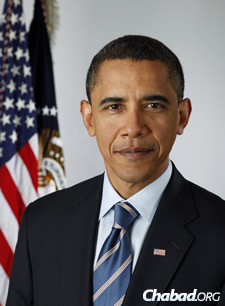
President Barack Obama
The anniversary of the Lubavitcher Rebbe’s birth—Rabbi Menachem M. Schneerson, of righteous memory—is again officially a day of special note for American citizens. President Barack Obama signed a proclamation declaring March 31, 2015, corresponding to the 11th day of the Hebrew month of Nissan, as “Education and Sharing Day, USA.”
In a document dated March 30 and made public Monday by the White House, the president honored the Rebbe’s longstanding efforts in education for Jews and non-Jews alike, noting that the Rebbe dedicated his life to promoting education as the cornerstone of humanity. A tireless advocate for youth around the world, the Rebbe believed that “as long as there is still one child that does not receive an adequate education, we can neither be satisfied nor slacken our efforts,” wrote the president.
“Because of leaders like the Rebbe, we have made great strides toward achieving quality education for all—but his legacy is not only a story of progress, it is also a call to remember his words and take up this unfinished task,” according to the document, which focused on girls, in particular, and the need to boost their educational opportunities.
“Across the globe, girls have pushed forward to pursue an education in the face of poverty and threats to their safety. They are bold, ambitious, and undeterred by immense challenges,” stated Obama. “Today, we are called to meet their resolve with a commitment worthy of their character. On Education and Sharing Day, U.S.A., we recognize educators, pioneers of change, and all those who have unlocked the spark of something extraordinary within a child, and we rededicate ourselves to building a world where the destiny of every young person is limited only by the size of their dreams and the power of their imagination.”
The first public recognition of the anniversary of the Rebbe’s birth was prompted in 1978 by Rabbi Abraham Shemtov, at the time the Rebbe’s personal envoy to Washington, D.C., who worked with congressional members to urge U.S. President Jimmy Carter to declare the day “Education and Sharing Day” in the Rebbe’s honor. That goal came to fruition, and the day was formally inaugurated on April 18, 1978. It has been deemed such by all succeeding presidents.
A few years later, in recognition of the Lubavitcher Rebbe’s 80th birthday, the U.S. Senate and the House of Representatives issued House Joint Resolution 447 to set aside April 4, 1982, as a “National Day of Reflection.”
At the time, President Ronald Reagan declared: “The Lubavitcher Rebbe’s work stands as a reminder that knowledge is an unworthy goal unless it is accompanied by moral and spiritual wisdom and understanding. He has provided a vivid example of the eternal validity of the Seven Noahide Laws, a moral code for all of us, regardless of religious faith. May he go from strength to strength.”
The full text of President Barack Obama’s proclamation appears here.
© Copyright 2015, all rights reserved.
Jewish News
Shmurah Matzah on More Seder Tables Than Ever Before by Faygie Levy
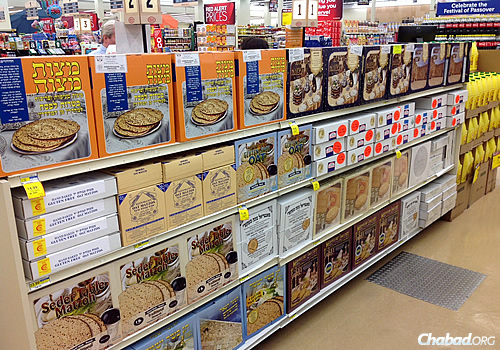
From small grocers in large Jewish population centers in the United States to chain supermarkets and even big-box retailers like Costco, there has been an explosion in recent years in the amount of shmurah matzah being produced and sold.
The hottest thing for Passover these days may be the one item you’d least expect.
Faux graham crackers? Infused olive oils? Sriracha sauce?
Try something much more basic. Demand, particularly in the United States, has been growing exponentially for round, handmade shmurah matzah. Shmurah means “watched” or “guarded” in Hebrew, and refers to the flour used to make the matzah being carefully watched to prevent any contact with water or moisture. The round matzahs are handbaked in the same time-hallowed way that Jews have been baking matzah for centuries. Throughout the process, the bakers keep in mind that their product is intended for the seder.
From small grocers in large Jewish population centers to chain supermarkets across the country and even big-box retailers like Costco, there has been an explosion in recent years in the amount of shmurah matzah being produced and sold. And, in many cases, simply given out.
With a whopping 70 percent of American Jews participating in a Passover seder—this year, the first seder takes place on Friday night, April 3, with the second on Saturday night, April 4—it’s no surprise that matzah is big business. What does seem rather surprising is the growing number of people specifically looking for shmurah matzah—also referred to as “seder matzah”—once served primarily by the strictly Orthodox.
Its importance as a necessary item on the Passover table brought it to none other than the White House, where it’s served at the president’s annual Passover seder.
“We have always carried shmurah matzah in a small number of our stores,” says Ahron Scharman, local business manager who handles kosher products for Bi-Lo Holdings, which runs some 800 stores in the southeastern United States, including the popular Winn-Dixie chain in Florida. “We recently expanded our shmurah product offerings, as well as increased the amount of stores that carry them.”
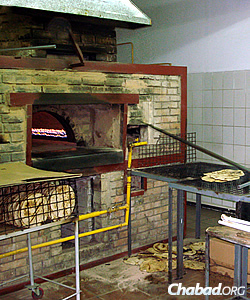
Baking shmurah matzah in Ukraine for distribution around the world.
Noting that nearly 230 of the chain’s stores now carry kosher-for-Passover items with 50 of them offering shmurah matzah, Scharman says “we have seen a steady increase in demand for shmurah matzah in the last several years. This can be attributed to the growth of the Jewish population in several of our markets.”
Yakov Yarmove oversees ethnic marketing and specialty foods at Jewel Osco, a supermarket chain with stores in Iowa, Indiana and Illinois, and has also seen the interest in shmurah matzah rise in recent years.
“I’ve been doing this for 23 years—this is my third supermarket chain—and I’ve watched the progression. In just the last six years, sales of shmurah went from heimishe [very traditional] people to just about everyone buying a box.”
He notes that of the chain’s 185 stores, nearly 100 sell shmurah matzah.
Now available in spelt, oat and whole wheat—and produced by special bakeries in New York, Canada, Israel and Ukraine—it may seem like there’s a variety of round, handmade matzah for every preference.
“There’s a changing tide, a shift in interest,” attests Rabbi Chayim Mishulovin, who runs the Chabad store “Everything Jewish” in Portland, Ore. He says as Chabad emissaries, “we are still telling people about shmurah matzah, but people are, on their own, trying to make sure they have this matzah for the seder.”
But that wasn’t always this case.
Machines Change Everything
For much of Jewish history—before the 1800s, specifically—matzah was all handmade, in a round or oval shape, so that’s what everyone ate.
But in 1838, a Frenchman named Isaac Singer invented a machine to roll matzah dough, making the process far less time-consuming. It represented the beginning of mass production, in addition to the start of a great controversy between handmade dough and the machine-made kind.
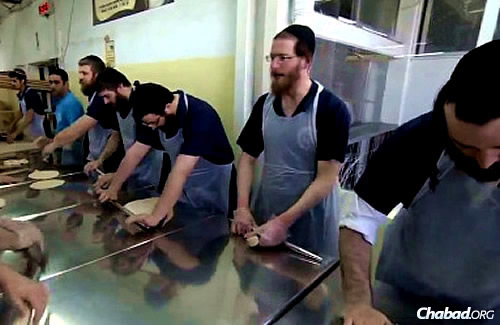
Rolling the dough for shmurah matzah at the historic bakery in Kfar Chabad, Israel.
Fifty years later, the first matzah-making factory was opened in Cincinnati by a Lithuanian Jewish immigrant named Dov Behr Manischewitz, called the B. Manischewitz Company. Matzahs were baked and packed in thin, hardy sheets, mass produced for a Jewish population that was dispersing throughout the United States.
By 1920, the factory was the world’s largest producer of matzah.
While some rabbis, especially Chassidic rabbis, prohibited their communities from eating machine-made matzah because of halachic questions (questions pertaining to Jewish law), it nevertheless grew in popularity with Jews because of its lower price, availability and uniform look, according to “How Matzah Became Square: Manischewitz and the Development of Machine-Made Matzah in the United States,” a speech given in 2005 at Touro College in New York by American Jewish historian Jonathan D. Sarna, a professor of American Jewish history in the department of Near Eastern and Judaic Studies at Brandeis University in Waltham, Mass.
According to Sarna, some European rabbis condoned the use of machine-made matzah for Jews in the United States, but not for their own communities because they understood that without it, the fast-growing American Jewish community “might not have sufficient matzah ... .”
By the 1950s, American Jews were eating such matzah at a fraction of the cost. Square matzah, especially those made by Manischewitz, had become a national brand, attests Sarna.
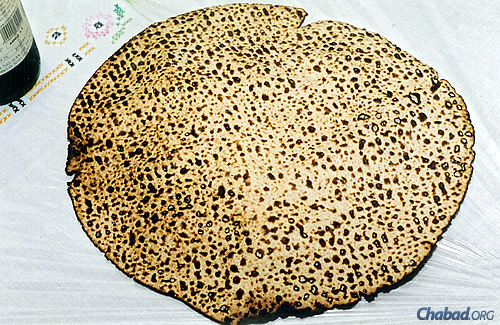
Once served primarily by the strictly Orthodox, a growing number of people are using shmurah matzah—also referred to as “seder matzah”—for the holiday.
The Rebbe’s Campaign
It was against this backdrop that the Lubavitcher Rebbe—Rabbi Menachem M. Schneerson, of righteous memory—began a campaign to have people distribute shmurah matzah in their communities.
“There was once a custom among community rabbis, they would distribute shmurah matzah to their congregants before the Pesach festival,” the Rebbe began in an address to his followers on April 3, 1954. “ ... For various reasons, the custom has been discontinued. I would like to say, that if I were able to, I would ask that the custom of distributing matzah be instituted and that rabbis give shmurah matzah to their congregants ... .”
The Rebbe went on to say that “thousands of Jews will benefit; as a result of this, they will have handmade kosher shmurah matzah.”
With that, the Rebbe’s shluchim started handing out the handmade and costly matzahs, which cound not be found in average stores or markets.
Among those who took the Rebbe’s challenge to heart was Rabbi Shmuel Dovid Raichek, a Chabad emissary in Los Angeles. He made it his mission to make sure that Jews in his community hadshmurah matzah for the Passover seder.
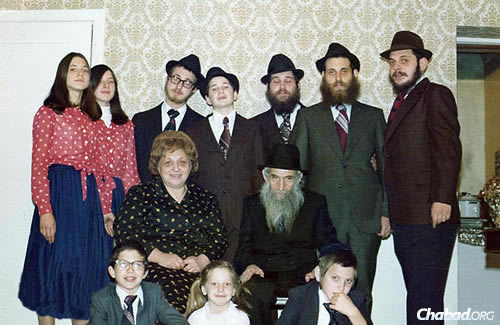
Devora Wilhelm, standing upper left, now co-director of Chabad Lubavitch of Oregon in Portland, with members of her family in Los Angeles in 1975. Delivering shmurah matzah was a big part of her childhood, encouraged by her parents, Rabbi Shmuel Dovid and Leah Raichik, shluchim to California. Her own son plans to hand out shmurah matzah at his upcoming bar mitzvah right before Passover.
“My father was a chassid of the Rebbe and a shaliach, and if it was important to the Rebbe, it was important to him,” states his daughter, Devora Wilhelm, who is now a Chabad emissary in Portland, Ore.
“We [all the Raichek children] remember going to downtown Los Angeles, to the businesses there, to give people shmurah matzah,” she recalls. “And on erev Pesach [Pesach eve], right before he went to shul and right before our seder, my father would make sure we took shmurah matzah to all our neighbors so they would have it at their seders.”
All that sounds simple enough, but it was anything but, according to Wilhelm. In the 1960s, shmurah matzah had to be brought in from New York via train, packed in thin cardboard boxes and prone to breakage. A truck would then transport those boxes to the Raichek home, where it was stored in a closet or, when the orders got bigger, the garage.
“People would come to the house, and we’d stop whatever we were doing to take matzahs out of big, eight-pound boxes and repack them. I remember doing this not only for my father, but also at the first Chabad House in Los Angeles on Gayley Avenue with my sister, Suri Klyne, and my friend, Rivki Rabinowitz.”
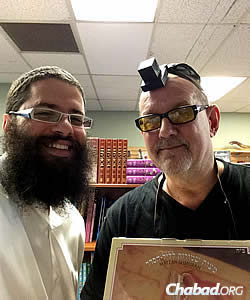
Rabbi Chayim Mishulovin, left, who runs the Chabad store “Everything Jewish” in Portland, Ore., with Eric Patton of North Portland, who came to buy Passover supplies and wound up wrapping tefillin for the very first time.
“After we grew up and went on shlichus, my father would ask us if we were giving out matzah, and if, so how much,” Wilhelm continues, noting that when she and her husband, Rabbi Moshe Wilhelm, first moved to Portland some 30 years ago, they would bring in between 40 to 50 pounds of shmurah matzah to distribute.
And though markets in Portland now carry it, Mishulovin, who happens to be Wilhelm’s son-in-law, imports some 500 pounds of shmurah matzah for distribution among the nine Chabad centers in Oregon, as well as promotes its sale at the “Everything Jewish” store. In addition, he is continuing the Chabad tradition of personally handing out matzah prior to Passover. He says the number of it in pounds keeps increasing year after year.
‘Importance of This Mitzvah’
The surge in distribution and usage of shmurah matzah is not, however, limited to the United States. Around the world, Jews are looking for what some call a more “authentic” matzah.
Consider South Africa, for example.
“Thirty-five years ago, a total of 300 kilos [66 pounds] of handmade shmurah matzah was brought into South Africa. This year, the total is in excess of 1,400 kilograms,” or more than 3,000 pounds, according to Rabbi Yossi Baumgarten, a shaliach in Johannesburg. “This is even more amazing when you consider that in that 35-year period, the community has decreased by about 30 percent.”
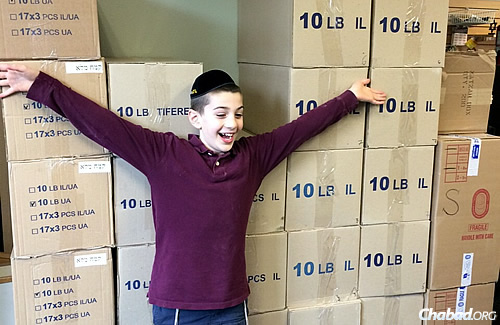
Mishulovin's son and Wilhelm's grandson, Shmuel Dovid (named for Devora Wilhelm's father), displays boxes and boxes of shmurah matzah at the store his father runs in Portland, Ore.
Baumgarten believes that the growth is “mainly due to the dedicated shluchim of South Africa, who, acting on the Rebbe’s directive, go out of their way to distribute shmurah matzah all over South Africa in the weeks between Purim and Pesach. Many recipients, in turn, have realized the importance of this mitzvah and now look to buy handmade shmurah matzah for their families—at least for the Pesach seder.”
Yarmove of the Jewel Osco supermarket chains agrees. “There’s absolutely no doubt in my mind [that] the Rebbe planted those seeds. They are now a forest and paying dividends,” he says. “No doubt about it.”
One other thing that’s adding to the increase in interest is the price point. While handmade shmurah matzah can sell for upwards of $25 a pound—in some cases, even exceeding $30 a pound for specialty matzah like oat—Yarmove, Mishulovin and others note that they do what they can to keep costs down.
Mishulovin sells boxes for $18, while Yarmove makes sure that his stores carry a variety of different types of shmurah matzah at different price points. Yarmove has even started carrying a three-piece package of matzah that retails for $6.99 and provides enough for a seder; moreover, it’s made a bit thicker and doesn’t break as easily as some other types.
As for Wilhelm, she’s continuing in her father’s footsteps.
Noting that her youngest son will celebrate his bar mitzvah just days before the start of Passover, Wilhelm says attendees will be going home with a unique party favor: “We are giving away between 60 and 80 boxes of shmurah matzah so people will have some for the seder.”
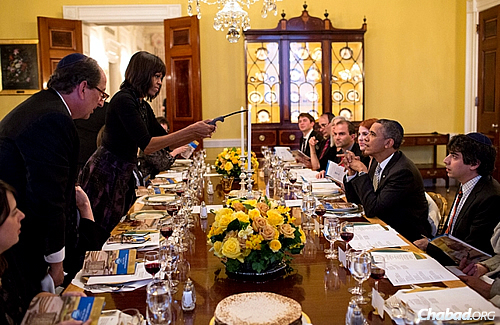
Shmurah Matzah at the White House: President Barack Obama and first lady Michelle Obama host an annual Passover seder at the White House for Jewish staff and friends. Here, a glimpse of the table in 2013 that included handmade shmurah matzahs. (Official White House Photo: Pete Souza)
Making matzah and memories at the historic bakery in Kfar Chabad, Israel can be read here.
Despite the ongoing trials of history in Ukraine, shmurah matzah remains an important local industry. Read about it here.
© Copyright 2015, all rights reserved.
Jewish News
Record Passover Aid on the Way to Tens of Thousands in Israel by Chabad.org Staff
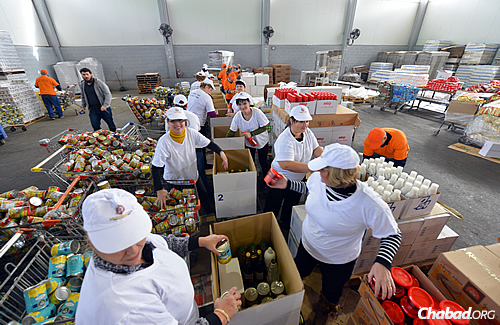
Volunteers pack up boxes of kosher-for-Passover items as part of Colel Chabad's largest food drive to date, which will be distributed to those in need in time for the holiday. (Photo: Israel Bardugo)
In preparation for the upcoming Passover holiday, Israel’s longest-running charity, Colel Chabad, has initiated its largest food drive to date.
The effort will benefit some 19,800 families, individuals and Israel Defense Forces soldiers in 56 municipalities and army bases throughout the country, with tens of thousands of food boxes packaged and distributed before the onset of the holiday. An additional 16,500 seder meals are being prepared and delivered for public seder meals at various Chabad Houses around Israel.
Chosen by Israel’s Welfare Ministry and the American Jewish Joint Distribution Committee to implement the national Israel Food Security Project, Colel Chabad provides families in need with food supplies and basic necessities, but also works to get them off welfare through training, education and other support initiatives. The project gives beneficiaries the choice of either receiving food packages or an equivalent financial subsidy, which can be used at a customized online store belonging to Colel Chabad and delivered directly to their homes.
The project has become so efficient that employees are able to collect and shop for the average-size online order in less than two minutes; food boxes are expertly packaged at a rate of seven boxes per minute.
“We pride ourselves on being a very professional, thorough and organized operation that allows us to best help those in need, but our primary goal is to ensure the recipients gain both the joy of the holiday and a sense of dignity,” says Rabbi Menachem Traxler, director of volunteering for Colel Chabad. “Every beneficiary receives a package that is designed with their specific needs in mind, and has been reviewed and approved by the project’s nutritionist, so they can truly appreciate that they are being cared for and thought about personally.”
Additionally, the project has become an important source of employment, with 50 workers, primarily immigrants from the former Soviet Union, operating year-round in an 8,000-square-meter packaging and distribution facility in the city of Kiryat Malachi, south of Tel Aviv.
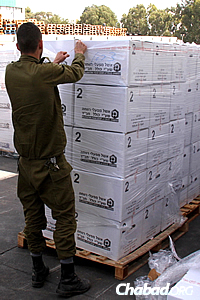
Soldiers of the Israel Defense Forces pitch in to help load the boxes. (Photo: Israel Bardugo)
Packaging for the Passover program began two weeks before the holiday to benefit the needy and the elderly, as well as soldiers and their families, who could use the extra support during the expensive holiday season.
The inventory this year includes 52,500 liters of oil; 18,750 kilograms of machine-made shmurah matzah; 22,500 pieces of handmade shmurah matzah; 70,000 liters of grape juice/wine; 7,000 bags of kosher-for-Passover cereal; 52,500 packages of sugar; 17,500 packages of salt; 12,250 bags of kosher-for-Passover cookies; 21,000 kilograms of olives; 14,000 containers of chocolate spread; and 17,500 kilograms of matzah meal.
Caring and Purpose
“The bitter reality is that poverty and hunger are an ingrained part of Israeli society, and while there are no easy solutions, we can’t simply throw our hands in the air and allow these people to despair,” says Rabbi Mendy Blau, Israel director of Colel Chabad. “Our model is to let these people know that they are being cared for, but give them a sense of purpose that we know will best help them get on their feet and become self-sufficient in the quickest manner possible.”
The 2015 Passover food program has been strongly supported by the International Fellowship of Christians and Jews, under the direction of its founder and president, Rabbi Yechiel Eckstein.
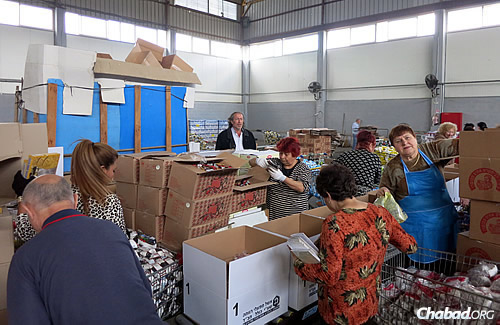
Colel Chabad has been chosen by Israel’s Welfare Ministry and the American Jewish Joint Distribution Committee to implement the national Israel Food Security Project. Beneficiaries can get either a food package or a financial subsidy. (Photo: Israel Bardugo)
Orna from Karmiel, a city in northern Israel, works a full-time job in a supermarket; her husband is a teacher. “When we found out our son needed special medical care, we started to put every shekel we had to make sure he got what he needed,” she explains. “It got to a point where we wouldn’t be able to buy basic food items.
“Thank G‑d, our social worker was able to get us assistance from Colel Chabad. We are now able to focus on our son’s health, knowing that we will have our basics taken care of.”
Founded in 1788, Colel Chabad was developed as an initiative of the first Chabad Rebbe—Rabbi Shneur Zalman of Liadi—to support the small Jewish presence in the Holy Land. Since then, it has continuously maintained and developed its charitable activities, becoming an integral part of modern Israel’s welfare infrastructure.
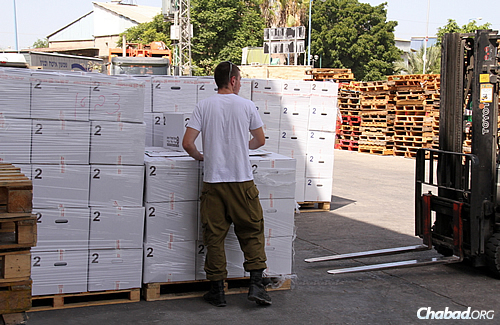
Moving the packed items onto the forklift ... (Photo: Israel Bardugo)
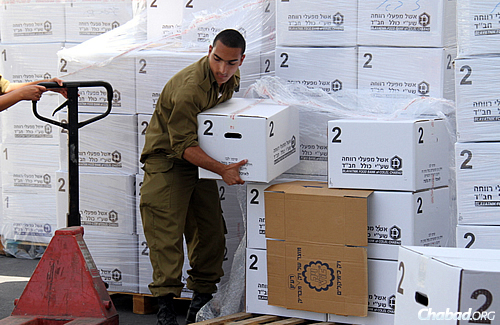
... and getting them ready to go. (Photo: Israel Bardugo)
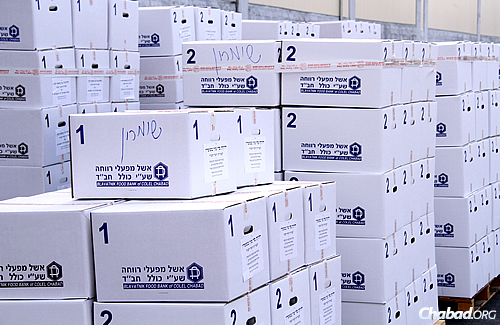
Thousands of boxes wait to be distributed to Israelis in need from the warehouse in Kiryat Malachi. (Photo: Israel Bardugo)
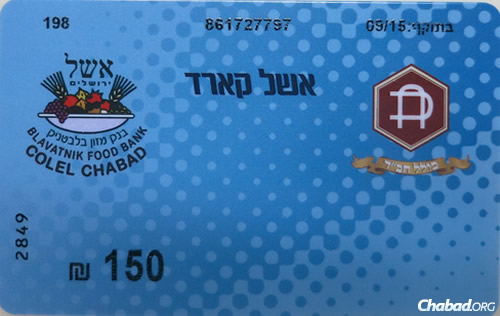
Colel Chabad debit cards can be used by beneficiaries to purchase food and other holiday supplies.
© Copyright 2015, all rights reserved.
Jewish News
Back to Cartagena for a Seder Awash With Tourists by Menachem Posner
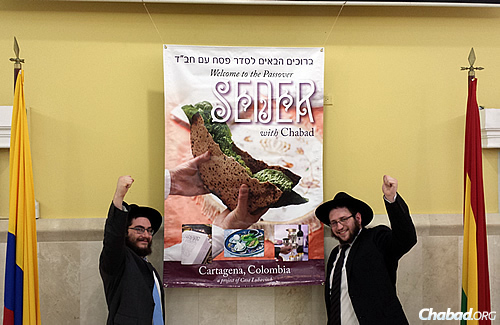
Rabbinical students Zalmy Goldberg, left, will lead a Passover seder in Cartagena with fellow studentChaim Eilenberg, both 22. This is the fifth year in a row that Goldberg has gone to Colombia to do so as part of the Chabad-Lubavitch “Roving Rabbis” program.
For many rabbinical students, Passover brings a fresh opportunity to travel to other communities—some of them quite exotic—and lead the seder there as part of the “Roving Rabbis” program.
While many of his peers prefer new locales every year, Zalmy Goldberg, a 22-year-old from Brooklyn, N.Y., will return to the same destination for the fifth year in a row: the port city of Cartagena, Colombia.
“I first went there when I was 18,” says Goldberg, now a senior student at the Mayanot Institute of Jewish Studies in Jerusalem, “and I’ve been going every Passover since, and sometimes for Sukkot and Chanukah as well.”
Cartagena’s Jewish community is miniscule. Yet Goldberg says he expects more than 225 people to participate in the seder, most of them Israeli and American tourists.
“Last year, we prepared for 170 people and around 225 showed up,” he reports. “This year, we are expecting an even larger turnout, with many more Americans now that there are direct flights from a number of American cities.”
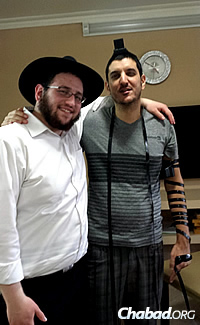
Helping men put tefillin on while there.
While Goldberg and fellow student Chaim Eilenberg, 22, will be conducting their seder in Cartagena, another pair of rabbinical students will be doing the same in nearby Taganga, a tiny fishing village that’s become a popular tourist destination. As word has gotten around that an Israeli-owned hotel in the village is booked, the students are looking forward to what may be significant attendance at their seder as well.
Few Local Connections
Goldberg is no stranger to the area. His sister, Chana Liberow, co-directs Casa Lubavitch-Barranquilla—a three-hour drive to the northeast along Colombia’s Caribbean coast—with her husband, Rabbi Yossi Liberow.
The rabbinical students’ trips are a joint venture of the Barranquilla Chabad center, Rabbi Yehoshua Rosenfeld of Casa Lubavitch-Bogota and Merkos L’Inyonei Chinuch, the educational arm of the Chabad-Lubavitch movement, which will dispatch 500 rabbinical students to conduct Passover seders in 50 countries this year.
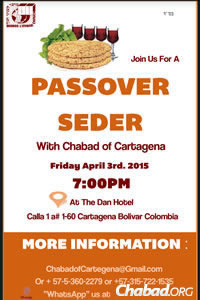
Publicizing the seder on the first night of the holiday.
Since no kosher catering facilities exist in Cartagena, all of the food is prepared in Barranquilla. The seder is held in a rented hotel near the hotels where the Israeli tourists tend to stay.
Even as he prepares for his eighth trip to the city, Goldberg says he has few local connections since most of the people he meets on his visits are long gone before he returns. Still, he mentions that he has bumped into a few people he met in Cartagena in the most random places, including his tefillin route in Manhattan, and once, in a bowling alley in Holon, Israel.
Of the latter chance meeting, he recounts: “The man behind the counter looked at me, and I looked at him. And then we both said, ‘I know you. Were you in Cartagena?’ ”
This year’s seder will be held at the Dan Hotel, Calla 1a # 1-60, Cartagena, Bolivar, Colombia. For information or to make a reservation, email ChabadofCartagena@gmail.com or call 347-461-0495 or (+575-355-2955).
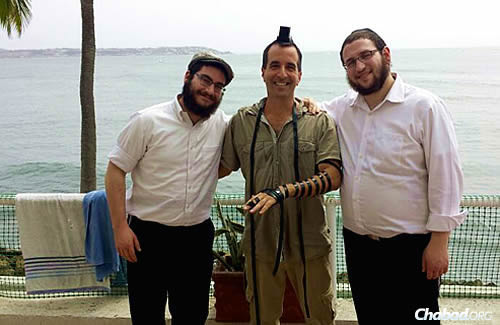
Israeli and American tourists are the majority of guests that Goldberg, left, and Eilenberg will serve.
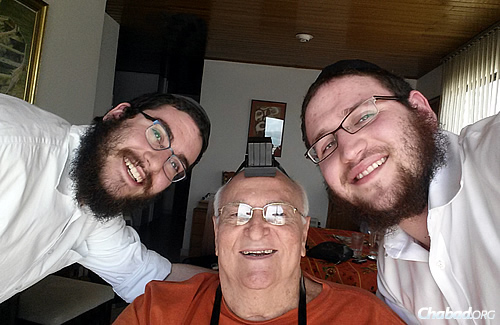
Goldberg has few local connections since most of the people he meets in Cartagena are different one Passover from the next; still, he has managed to bump into a few familiar faces from the seders in some random places.
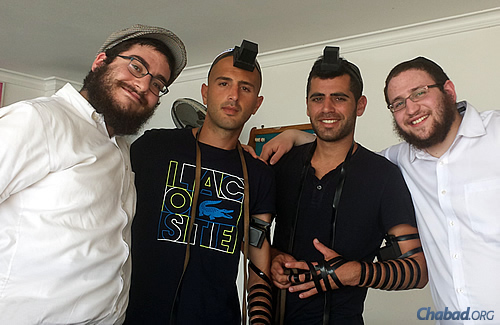
The two young rabbinical students with two young visitors donning tefillin.
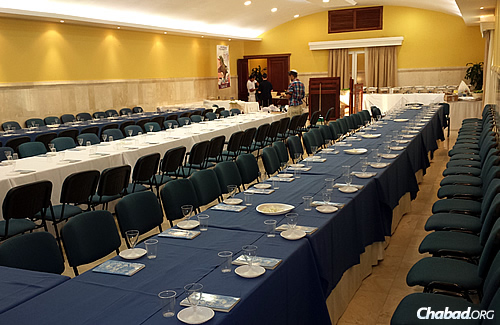
About 170 people were expected last year for the seder, yet 225 showed up; this year, preparations are being made for an even larger turnout.
© Copyright 2015, all rights reserved.
Lifestyle
Make: 4 Simple Types of Charoset By Miriam Szokovski
Less than a week until Seder night means it’s definitely time to start thinking about the Seder plate foods, including charoset—a mixture of apples, nuts and wine which resembles the mortar and brick made by the Jews when they toiled for Pharaoh. This is used as a type of relish into which the maror (bitter herb) is dipped (and then shaken off) before eating.
Click here to learn more about the meaning behind charoset.

The base of any charoset is sweet apple and/or pear, walnuts and red wine. Fruit—small dice, large dice or grated, that’s up to you. Nuts chopped or ground—again, up to you. It’s a matter of taste. Can’t decide? Make a few versions and have a vote.

Some people like to add dried fruit like raisins, dates, prunes or apricots, and spices like cinnamon, nutmeg, cloves or allspice. Dessicated coconut can add another layer of texture and is good alternative for the nut-allergic.
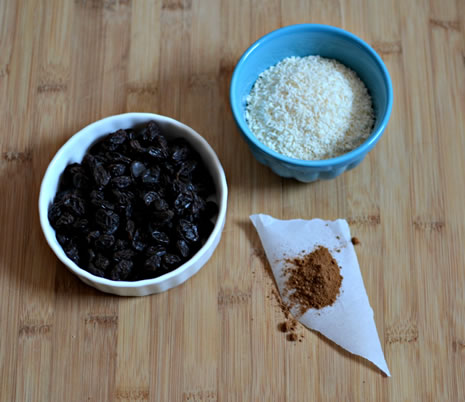
I’ve got four variations for you here, but feel free to play around and come up with your own.
Simple Chabad-Style Charoset
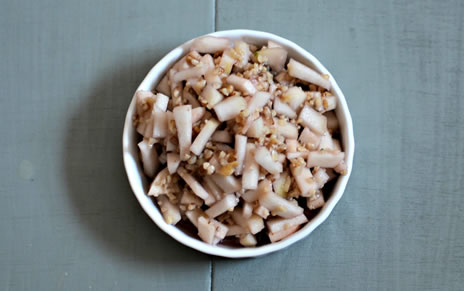
1 red apple
1 pear
1 cup chopped or ground walnuts
½ cup sweet red wine
Peel and finely dice the apple and pear. Mix in the ground nuts and wine. Refrigerate until serving. Add a little more wine immediately before serving.
Chunky Charoset
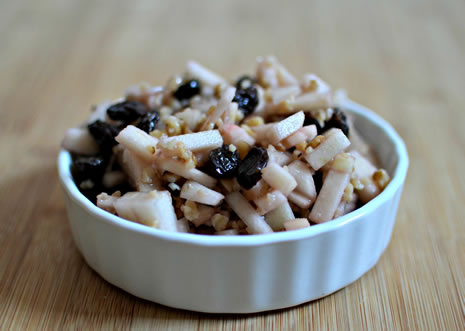
1 apple
1 pear
1 cup chopped or ground walnuts
½ cup raisins
½ cup sweet red wine
¼ tsp. cinnamon
¼ tsp. nutmeg
Peel and finely dice the apple and pear. Mix in the ground nuts, raisins, wine and spices. Refrigerate until serving. Add a little more wine immediately before serving.
Smooth Charoset
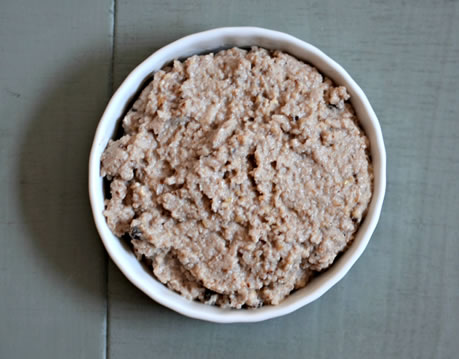
Use any of these recipes and pulse in a food processor until it reaches a thick paste consistency.
Nut-Free Charoset

1 apple
1 pear
1 cup desiccated coconut
½ cup raisins
½ cup sweet red wine
Peel and finely dice the apple and pear. Mix in the rest of the ingredients. Refrigerate until serving. Add a little more wine immediately before serving.
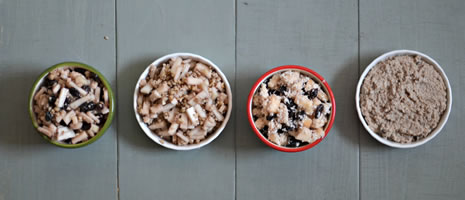
There’s one major “problem” with charoset—it’s customary to shake the charoset off the maror before eating, but the charoset is quite delicious! So, set some charoset aside in a separate container for later use. Mix it into your breakfast yogurt, or serve warm with a scoop of vanilla ice cream.
What kind of charoset will you be making for Passover? Got a special family recipe? Leave a comment and share it with us!
Miriam Szokovski is the author of historical novel Exiled Down Under, and a member of the Chabad.org editorial team. She enjoys tinkering with recipes, and teaches cooking classes to young children. Miriam shares her love of cooking, baking and food photography on Chabad.org’s food blog, Cook It Kosher and in the N'shei Chabad Newsletter.
© Copyright 2015, all rights reserved.
Lifestyle
Cook: Vegetarian Mock Chopped Liver By Kenden Alfond
This plant-based version of chopped liver dip makes a lovely addition to your holiday meal. Mushrooms and walnuts give this dip a unique flavor that everyone will enjoy. Serve with crunchy, fresh celery and matzo crackers.
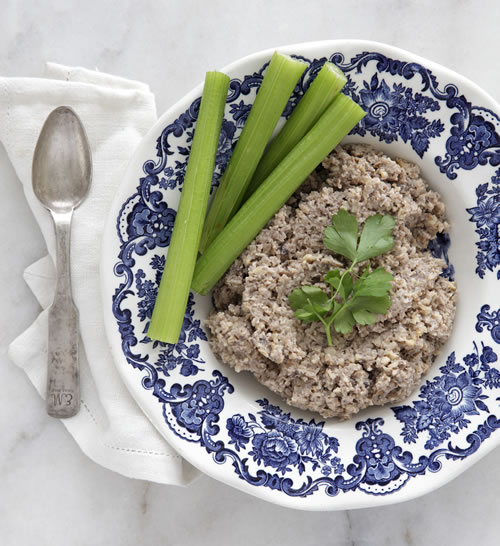
Ingredients
¼ cup vegetable broth (or water)
½ cup chopped onion
2 cloves garlic, minced
2 cups button mushrooms, cleaned and sliced
½ teaspoon sea salt
½ cup walnuts
1 teaspoon balsamic vinegar
Black pepper, to taste
Garnish: fresh parsley
Serve with: 6 stalks celery, cut into sticks, and matzo crackers
Directions
In a large skillet, heat vegetable broth (or water) over medium-high heat. Add the onion and garlic and sprinkle with a few pinches of the sea salt. Sauté for 10 minutes, adding a touch more vegetable broth (or water) if the onion begins to stick to the skillet.
Add the mushrooms and another few pinches of sea salt . Add a little bit more vegetable broth if needed. Cook and stir for 5 more minutes, or until the mushrooms have softened.
Place the cooked vegetables, remaining sea salt, walnuts, balsamic vinegar and black pepper in a food processor. Blend until well-blended but not completely smooth. Adjust seasoning to taste.
Place in a serving bowl. Garnish with fresh parsley. Serve with celery sticks and matzo crackers.
Kenden Alfond is the editor and creator of Jewish Food Hero, a site that offers beautiful resouces and plant-based menus for the Jewish holidays. She has spent the last 10 years living and working around the world on humanitarian, post-conflict, and development issues with the United Nations and several NGOs. You can also find her on Instragram.
© Copyright 2015, all rights reserved.
Lifestyle
Craft: Splitting the Sea By Estee Lavitt
The Passover Seder revolves around the Exodus from Egypt. Upon leaving Egypt, the Jews faced the Red Sea. G-d performed a miracle and Moses split the sea, allowing the Jews to walk through on dry land.
We searched high and low for a great project to depict Moses at the sea but we came up empty handed. So we crafted one ourselves!
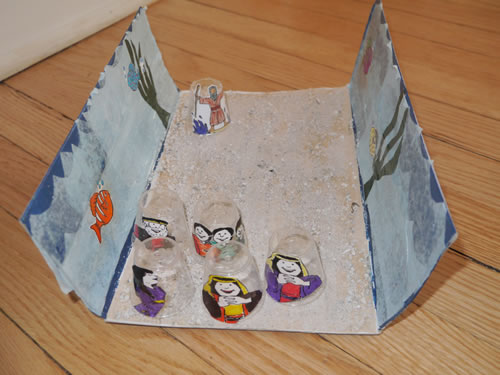
Teachers and parents will enjoy this new craft that helps children visualize the well-known story and allows them to play along. This diorama is simple to make and your children can continue to recount the miraculous event long after the week of Passover has passed.
You will need:
1 Sturdy shoebox
Blue paint and brush
Mod-Podge and a sponge brush
Light blue, light brown, and green tissue paper
Sand
Small plastic shot glasses
Character printouts and markers (or plain paper and draw the characters yourself)
Scissors
Tape
Twine or ribbon
Tag
Zip-top bag
Step 1:
Select a sturdy shoebox. Ours is light blue. Cut along the corner edges as shown. Paint the 2 longer sides dark blue.

Step 2:
Cut strips of light blue tissue paper into waves by cutting rounds into the top. Apply Mod-Podge over the painted area and place tissue paper across both sides. Apply a generous coating of Mod-Podge to seal the tissue paper.
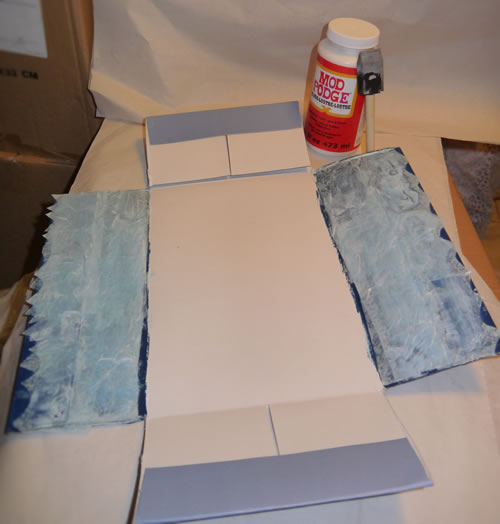
Step 3:
Cut off the short edges of the shoebox. Generously coat the middle section with Mod-Podge and place brown tissue paper down the center. Trim any excess so it fits the center of the box. Apply another coat of Mod Podge and pour sand onto the tissue paper. Shake off excess.
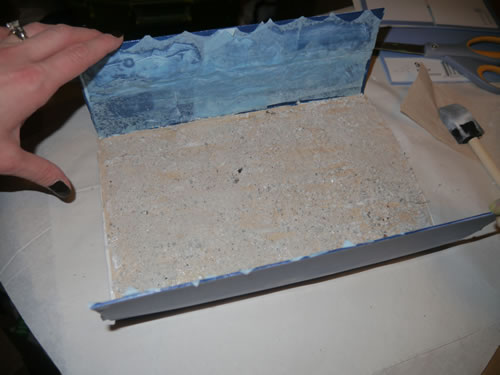
Step 4:
Cut out green tissue paper for seaweed and affix to the sides of the box using Mod-Podge under and on top of the paper. Print out and color some fish pictures and add to sides. Color Moses and tape onto a shot glass.
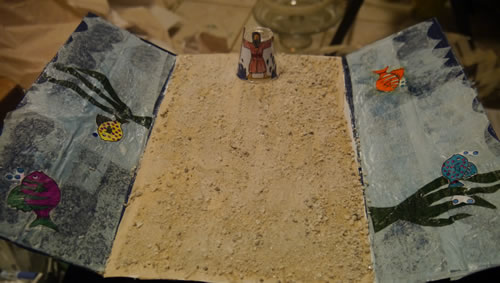
Step 5:
Print and color more people and affix to shot glasses with tape. You can make as many as you want! Your kids can play with the figurines and have them cross the Red Sea over and over again.
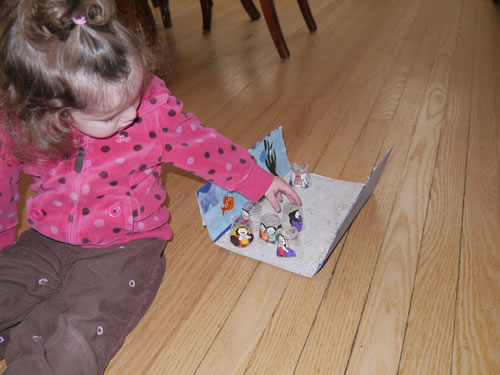
Step 6:
Wrap the box with twine. A zip-top bag holds all the figurines.
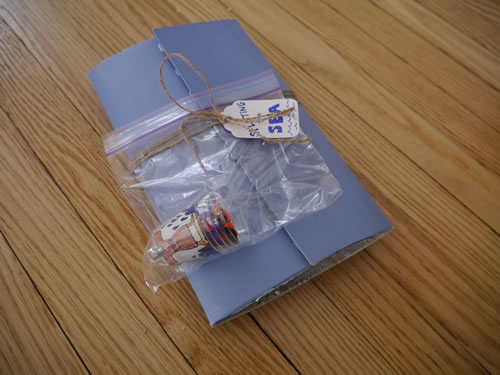
JCreate is an online Jewish crafting magazine.
© Copyright 2015, all rights reserved.
For the Kids
Complete Your Passover Mission
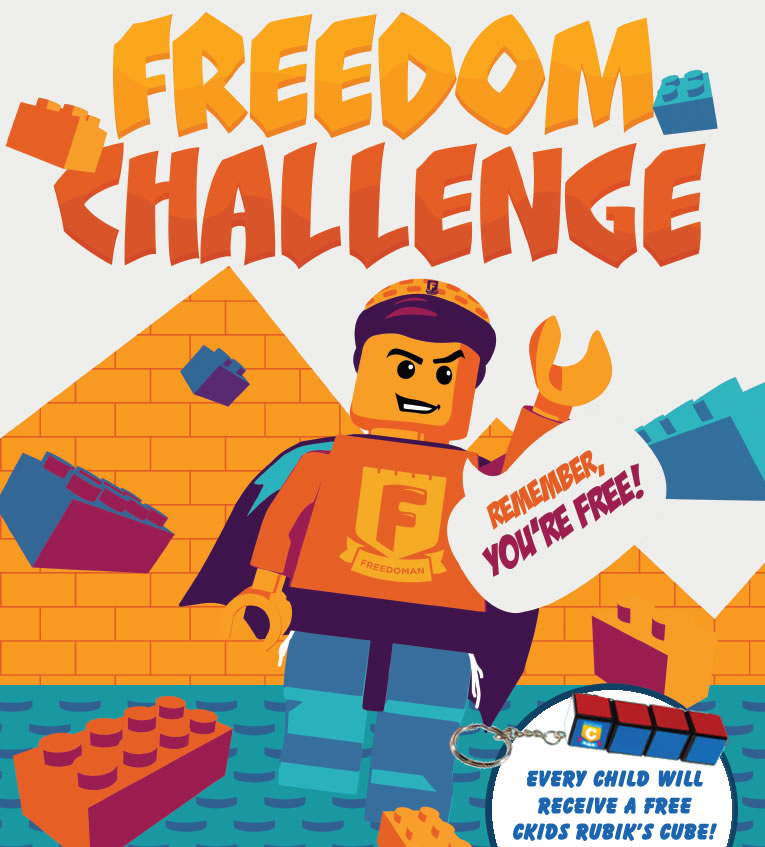

Join the Passover Freedom Challenge Right Here!
Every year, we have a chance to remember the great miracles performed for us over 3,000 years ago. G-d freed our ancestors from slavery in Egypt and chose us as a proud Jewish nation to receive His Torah -- but the story doesn't end there. Every day we can relive our freedom!
After Passover, check off the missions you completed.
Every child that enters will recieve the CKids Rubiks Cube and will be entered into the raffle for many cool prizes... Plus each completed mission gives you an additional chance in the raffle!
Click here to prepare for the Freedom Challenge
4 Steps to take the CKids Freedom Challenge:
Clean your bedroom* for Passover:
Search for chametz
Place any found chametz in a designated bin or cabinet.
Cut out the provided “Cleaned for Passover” sign.
Hang the sign on your bedroom door
*) Chametz should be removed from all your possessions or set aside and sold to a non-Jew for the duration of Passover.
Shop for The Big Three:
Buy “The Big Three” (or check that you have them at home)
Set aside “The Big Three” for the seder in a place that has be cleaned for Passover
Light the Candles:
On Friday, April 3rd, (before sunset) boys and girls set up the candles. (There should be at least two for your mom and one for each girl.)
Girls and women light the candles before sunset*, then circle their arms around the candles three times and recite the blessings (Click here to print the blessing.)
Eat “The Big Three”
and talk about freedom:
On Friday, April 3rd, set up “The Big Three” at your seder table.
Sit down with your family for a seder in the evening.
Sit down with your family for a seder in the evening.
Relive the freedom from Pharaoh by eating “The Big Three.”
Lead the Freedometer Game at your seder table.
Win these Cool Prizes:
How a Puny Jewish Girl Stopped a Gang War By Yehudis Fishman

Perhaps because of our shared histories of slavery and injustice, the Jewish and African American communities have always been intertwined, whether we are marching together for civil rights or, unfortunately, at odds with each other. One incident from my adolescence stands out in my mind . . .The Jewish and African American communities have always been intertwined
The year was 1960, and at 17 I had my first after-school job working on the outskirts of Boston in a coat factory. My coworkers were mainly African Americans, and, suffice it to say, I felt quite intimidated being the only white Jewish girl in a strange environment. Still, I met enough interesting—though volatile—characters to make the time go by during what was otherwise very boring work. One day, however, would be etched in my adolescent memory forever.
I went to work straight from school on the long trolley ride. I arrived a few minutes late, having stopped to unobtrusively daven the afternoon prayer in a then-still-existing phonebooth. When I entered the factory, even before reaching the coat-sorting room, I heard angry shouts, banging and desperate cries. I snuck in between the waving fists and went to my designated pile of coats. From the corner of my eye, I caught the gist of the argument. Two burly, muscular men were fighting over the affections of a beautiful, slender young woman. One of the men, whose explosive character I had noticed on earlier days, went into a huddle with a few of his friends. I heard him murmur something like, “Okay, guys, this is gonna be the end for him and all his pals. No one messes with my girl and gets away with it. Bring your weapons in tomorrow.”
I took a deep breath and almost swooned from the drama. To my sheltered existence, it was like being on a live movie set—only it was real life! I went home and imagined myself in some heroic role. I had always been sensitive to stories of confrontations and injustice, both in my religious and secular subjects. I was deeply moved by plays like Antigone and A Man for All Seasons, where people stood up for what they believed in. My Torah heroes were Moses, who defended the Jews, and David, who battled with wild beasts to save his flock and with a giant to save his people.
I was up half the night wrestling with myself. Could I, an orphan living on welfare, do anything at all to stave off the potential gang war that could erupt tomorrow? Till that point, I had basically kept to myself and didn’t really know much about any of my fellow employees—their lives, their culture, their way of resolving issues . . . But it could not have been an accident that I was there and overheard the argument. One thing I believed more and more from my recent exposure to chassidic teachings was that we could see the hand of divine providence everywhere, if we took the time to look.
When Moses was at the burning bush, the Torah says, “He turned to see,” and Rashi comments that he said, “I will turn from here to get close to there.” Imagine what would have happened if he just went on his way and ignored the whole scene—maybe we Jews would not be here to talk about it! We all need, at times, to turn from our comfort zone toward something new and unexpected. As G‑d introduced Himself to Moses, “I will be what I will be.” The future is what we make of it, with G‑d’s help.
This was the kind of self-talk I gave myself most of the night. At school the next day, I was simultaneously tired and wired, and I could barely wait for school to be over. With a pounding heart, I crept into the coat factory. Sure enough, as if no time had passed, the yelling and the brandishing were escalating. I think I said the 23rd psalm to myself before I got up the nerve to walk over to the gang leader who had planned the battle. I knew he was powerful and hot-tempered, but what did I have to lose? I strained my neck and looked straight into his eyes. I had a plan; I had to act. And if he resisted like Pharaoh, so be it.I heard angry shouts
I began, “Is this the only way you can think of to handle this?”
He looked down at me as if I were one of the grasshoppers in Canaan. “And how would you ‘handle’ this?” he said sarcastically.
“Well”—here I paused, more from fear than dramatic effect—”‘I would write a letter.”
“A letter? What the #$%@ would that do? What would I say and who should it go to?”
“I think you should write one to your girlfriend, and maybe even one to the other guy.”
“What the #$%@ would I say?”
“Just tell her how you feel about her hanging out with the other guy, and how much you care about her! And you can tell the other guy that you don’t appreciate him taking your girl away from you!”
I could see he was actually thinking about it, but he was shaking his head at the same time. Uh, oh, what’s wrong now? I thought to myself. He bent his head ominously toward mine. I cringed. He looked around to make sure no one else could hear him. “I . . . I . . . can’t write . . . I never learned . . .”
Oy, this was not part of my plan. Then I recalled Moses’ words. I believed that Moses was also murmuring to me, “You must turn from here to go there.” And it was as if Moses’ family was encouraging me too. Yocheved, mother of Moses, who was born at Egypt’s border because she had to transmit to her son how to live in two worlds, how to find a path to freedom even when feeling the pains of slavery. Aaron, who was the great peacemaker between couples and friends who had become estranged. And most of all, Miriam, who at five years old defied not only Pharaoh, but even her own parents when they separated. Miriam had walked right up to the most prominent couple in the Israelite camp and told them straight to their faces, “Your decision not to have children is worse than Pharaoh’s decree. He wants to eliminate the boys, but you’re preventing both boys and girls from being born!” Her courage and confidence spurred me on.
Ok, Miriam, I can do it.
“Fine, no problem,” I finally responded out loud to the young man. “I’ll help you write it.” I motioned to him to follow me to a hidden corner of the factory, where there was a stool big enough to lean on. I pulled out a notebook from my school bag, took out a few pens and pencils, and began. “Ok, shoot . . . I mean, speak your mind.”
Everything calmed down in the factory after that. I felt empowered, after that event, to handle whatever situation came my way, with G‑d’s help. And from then on, I knew with more resolve than ever that my life mattered—that all life mattered.I know that my life mattered
Years after my own foray into conflict resolution, New York City mayor David Dinkins visited the Rebbe after the Crown Heights riots in 1991. The Rebbe blessed him, “May G‑d Almighty bless you to have good news and to use all your influence in the quiet atmosphere, and much success.”
Dinkins responded, “Well, thank you, I shall do that. I’m confident that with the good people of all our communities—”
“Both sides.”
“—Both sides—we will come together and do those things necessary to protect everyone.”
The Rebbe added, “And to forget that it is ‘both sides.’ It is one side, one people . . .”1
The Rebbe’s sentiments echoed my own experience, that when you take the time to understand another’s culture and point of view, you see how similar you really are. Beneath the conflict, the humanity shines through.
Yehudis Fishman has been teaching Torah and chassidic philosophy to people of all ages and backgrounds for over fifty years. For the last six years she has been the spiritual director of congregation Aish Kodesh in Boulder, Colo., and continues to teach and counsel. Her qualities of erudition, relevance, sensitivity and humor endear her to a broad spectrum of multigenerational students.
FOOTNOTES
1. See chabad.org/1599198.
© Copyright 2015, all rights reserved.
Jewish News
President Obama Proclaims ‘Education and Sharing Day’ 2015 by Chabad.org Staff

President Barack Obama
The anniversary of the Lubavitcher Rebbe’s birth—Rabbi Menachem M. Schneerson, of righteous memory—is again officially a day of special note for American citizens. President Barack Obama signed a proclamation declaring March 31, 2015, corresponding to the 11th day of the Hebrew month of Nissan, as “Education and Sharing Day, USA.”
In a document dated March 30 and made public Monday by the White House, the president honored the Rebbe’s longstanding efforts in education for Jews and non-Jews alike, noting that the Rebbe dedicated his life to promoting education as the cornerstone of humanity. A tireless advocate for youth around the world, the Rebbe believed that “as long as there is still one child that does not receive an adequate education, we can neither be satisfied nor slacken our efforts,” wrote the president.
“Because of leaders like the Rebbe, we have made great strides toward achieving quality education for all—but his legacy is not only a story of progress, it is also a call to remember his words and take up this unfinished task,” according to the document, which focused on girls, in particular, and the need to boost their educational opportunities.
“Across the globe, girls have pushed forward to pursue an education in the face of poverty and threats to their safety. They are bold, ambitious, and undeterred by immense challenges,” stated Obama. “Today, we are called to meet their resolve with a commitment worthy of their character. On Education and Sharing Day, U.S.A., we recognize educators, pioneers of change, and all those who have unlocked the spark of something extraordinary within a child, and we rededicate ourselves to building a world where the destiny of every young person is limited only by the size of their dreams and the power of their imagination.”
The first public recognition of the anniversary of the Rebbe’s birth was prompted in 1978 by Rabbi Abraham Shemtov, at the time the Rebbe’s personal envoy to Washington, D.C., who worked with congressional members to urge U.S. President Jimmy Carter to declare the day “Education and Sharing Day” in the Rebbe’s honor. That goal came to fruition, and the day was formally inaugurated on April 18, 1978. It has been deemed such by all succeeding presidents.
A few years later, in recognition of the Lubavitcher Rebbe’s 80th birthday, the U.S. Senate and the House of Representatives issued House Joint Resolution 447 to set aside April 4, 1982, as a “National Day of Reflection.”
At the time, President Ronald Reagan declared: “The Lubavitcher Rebbe’s work stands as a reminder that knowledge is an unworthy goal unless it is accompanied by moral and spiritual wisdom and understanding. He has provided a vivid example of the eternal validity of the Seven Noahide Laws, a moral code for all of us, regardless of religious faith. May he go from strength to strength.”
The full text of President Barack Obama’s proclamation appears here.
© Copyright 2015, all rights reserved.
Jewish News
Shmurah Matzah on More Seder Tables Than Ever Before by Faygie Levy

From small grocers in large Jewish population centers in the United States to chain supermarkets and even big-box retailers like Costco, there has been an explosion in recent years in the amount of shmurah matzah being produced and sold.
The hottest thing for Passover these days may be the one item you’d least expect.
Faux graham crackers? Infused olive oils? Sriracha sauce?
Try something much more basic. Demand, particularly in the United States, has been growing exponentially for round, handmade shmurah matzah. Shmurah means “watched” or “guarded” in Hebrew, and refers to the flour used to make the matzah being carefully watched to prevent any contact with water or moisture. The round matzahs are handbaked in the same time-hallowed way that Jews have been baking matzah for centuries. Throughout the process, the bakers keep in mind that their product is intended for the seder.
From small grocers in large Jewish population centers to chain supermarkets across the country and even big-box retailers like Costco, there has been an explosion in recent years in the amount of shmurah matzah being produced and sold. And, in many cases, simply given out.
With a whopping 70 percent of American Jews participating in a Passover seder—this year, the first seder takes place on Friday night, April 3, with the second on Saturday night, April 4—it’s no surprise that matzah is big business. What does seem rather surprising is the growing number of people specifically looking for shmurah matzah—also referred to as “seder matzah”—once served primarily by the strictly Orthodox.
Its importance as a necessary item on the Passover table brought it to none other than the White House, where it’s served at the president’s annual Passover seder.
“We have always carried shmurah matzah in a small number of our stores,” says Ahron Scharman, local business manager who handles kosher products for Bi-Lo Holdings, which runs some 800 stores in the southeastern United States, including the popular Winn-Dixie chain in Florida. “We recently expanded our shmurah product offerings, as well as increased the amount of stores that carry them.”

Baking shmurah matzah in Ukraine for distribution around the world.
Noting that nearly 230 of the chain’s stores now carry kosher-for-Passover items with 50 of them offering shmurah matzah, Scharman says “we have seen a steady increase in demand for shmurah matzah in the last several years. This can be attributed to the growth of the Jewish population in several of our markets.”
Yakov Yarmove oversees ethnic marketing and specialty foods at Jewel Osco, a supermarket chain with stores in Iowa, Indiana and Illinois, and has also seen the interest in shmurah matzah rise in recent years.
“I’ve been doing this for 23 years—this is my third supermarket chain—and I’ve watched the progression. In just the last six years, sales of shmurah went from heimishe [very traditional] people to just about everyone buying a box.”
He notes that of the chain’s 185 stores, nearly 100 sell shmurah matzah.
Now available in spelt, oat and whole wheat—and produced by special bakeries in New York, Canada, Israel and Ukraine—it may seem like there’s a variety of round, handmade matzah for every preference.
“There’s a changing tide, a shift in interest,” attests Rabbi Chayim Mishulovin, who runs the Chabad store “Everything Jewish” in Portland, Ore. He says as Chabad emissaries, “we are still telling people about shmurah matzah, but people are, on their own, trying to make sure they have this matzah for the seder.”
But that wasn’t always this case.
Machines Change Everything
For much of Jewish history—before the 1800s, specifically—matzah was all handmade, in a round or oval shape, so that’s what everyone ate.
But in 1838, a Frenchman named Isaac Singer invented a machine to roll matzah dough, making the process far less time-consuming. It represented the beginning of mass production, in addition to the start of a great controversy between handmade dough and the machine-made kind.

Rolling the dough for shmurah matzah at the historic bakery in Kfar Chabad, Israel.
Fifty years later, the first matzah-making factory was opened in Cincinnati by a Lithuanian Jewish immigrant named Dov Behr Manischewitz, called the B. Manischewitz Company. Matzahs were baked and packed in thin, hardy sheets, mass produced for a Jewish population that was dispersing throughout the United States.
By 1920, the factory was the world’s largest producer of matzah.
While some rabbis, especially Chassidic rabbis, prohibited their communities from eating machine-made matzah because of halachic questions (questions pertaining to Jewish law), it nevertheless grew in popularity with Jews because of its lower price, availability and uniform look, according to “How Matzah Became Square: Manischewitz and the Development of Machine-Made Matzah in the United States,” a speech given in 2005 at Touro College in New York by American Jewish historian Jonathan D. Sarna, a professor of American Jewish history in the department of Near Eastern and Judaic Studies at Brandeis University in Waltham, Mass.
According to Sarna, some European rabbis condoned the use of machine-made matzah for Jews in the United States, but not for their own communities because they understood that without it, the fast-growing American Jewish community “might not have sufficient matzah ... .”
By the 1950s, American Jews were eating such matzah at a fraction of the cost. Square matzah, especially those made by Manischewitz, had become a national brand, attests Sarna.

Once served primarily by the strictly Orthodox, a growing number of people are using shmurah matzah—also referred to as “seder matzah”—for the holiday.
The Rebbe’s Campaign
It was against this backdrop that the Lubavitcher Rebbe—Rabbi Menachem M. Schneerson, of righteous memory—began a campaign to have people distribute shmurah matzah in their communities.
“There was once a custom among community rabbis, they would distribute shmurah matzah to their congregants before the Pesach festival,” the Rebbe began in an address to his followers on April 3, 1954. “ ... For various reasons, the custom has been discontinued. I would like to say, that if I were able to, I would ask that the custom of distributing matzah be instituted and that rabbis give shmurah matzah to their congregants ... .”
The Rebbe went on to say that “thousands of Jews will benefit; as a result of this, they will have handmade kosher shmurah matzah.”
With that, the Rebbe’s shluchim started handing out the handmade and costly matzahs, which cound not be found in average stores or markets.
Among those who took the Rebbe’s challenge to heart was Rabbi Shmuel Dovid Raichek, a Chabad emissary in Los Angeles. He made it his mission to make sure that Jews in his community hadshmurah matzah for the Passover seder.

Devora Wilhelm, standing upper left, now co-director of Chabad Lubavitch of Oregon in Portland, with members of her family in Los Angeles in 1975. Delivering shmurah matzah was a big part of her childhood, encouraged by her parents, Rabbi Shmuel Dovid and Leah Raichik, shluchim to California. Her own son plans to hand out shmurah matzah at his upcoming bar mitzvah right before Passover.
“My father was a chassid of the Rebbe and a shaliach, and if it was important to the Rebbe, it was important to him,” states his daughter, Devora Wilhelm, who is now a Chabad emissary in Portland, Ore.
“We [all the Raichek children] remember going to downtown Los Angeles, to the businesses there, to give people shmurah matzah,” she recalls. “And on erev Pesach [Pesach eve], right before he went to shul and right before our seder, my father would make sure we took shmurah matzah to all our neighbors so they would have it at their seders.”
All that sounds simple enough, but it was anything but, according to Wilhelm. In the 1960s, shmurah matzah had to be brought in from New York via train, packed in thin cardboard boxes and prone to breakage. A truck would then transport those boxes to the Raichek home, where it was stored in a closet or, when the orders got bigger, the garage.
“People would come to the house, and we’d stop whatever we were doing to take matzahs out of big, eight-pound boxes and repack them. I remember doing this not only for my father, but also at the first Chabad House in Los Angeles on Gayley Avenue with my sister, Suri Klyne, and my friend, Rivki Rabinowitz.”

Rabbi Chayim Mishulovin, left, who runs the Chabad store “Everything Jewish” in Portland, Ore., with Eric Patton of North Portland, who came to buy Passover supplies and wound up wrapping tefillin for the very first time.
“After we grew up and went on shlichus, my father would ask us if we were giving out matzah, and if, so how much,” Wilhelm continues, noting that when she and her husband, Rabbi Moshe Wilhelm, first moved to Portland some 30 years ago, they would bring in between 40 to 50 pounds of shmurah matzah to distribute.
And though markets in Portland now carry it, Mishulovin, who happens to be Wilhelm’s son-in-law, imports some 500 pounds of shmurah matzah for distribution among the nine Chabad centers in Oregon, as well as promotes its sale at the “Everything Jewish” store. In addition, he is continuing the Chabad tradition of personally handing out matzah prior to Passover. He says the number of it in pounds keeps increasing year after year.
‘Importance of This Mitzvah’
The surge in distribution and usage of shmurah matzah is not, however, limited to the United States. Around the world, Jews are looking for what some call a more “authentic” matzah.
Consider South Africa, for example.
“Thirty-five years ago, a total of 300 kilos [66 pounds] of handmade shmurah matzah was brought into South Africa. This year, the total is in excess of 1,400 kilograms,” or more than 3,000 pounds, according to Rabbi Yossi Baumgarten, a shaliach in Johannesburg. “This is even more amazing when you consider that in that 35-year period, the community has decreased by about 30 percent.”

Mishulovin's son and Wilhelm's grandson, Shmuel Dovid (named for Devora Wilhelm's father), displays boxes and boxes of shmurah matzah at the store his father runs in Portland, Ore.
Baumgarten believes that the growth is “mainly due to the dedicated shluchim of South Africa, who, acting on the Rebbe’s directive, go out of their way to distribute shmurah matzah all over South Africa in the weeks between Purim and Pesach. Many recipients, in turn, have realized the importance of this mitzvah and now look to buy handmade shmurah matzah for their families—at least for the Pesach seder.”
Yarmove of the Jewel Osco supermarket chains agrees. “There’s absolutely no doubt in my mind [that] the Rebbe planted those seeds. They are now a forest and paying dividends,” he says. “No doubt about it.”
One other thing that’s adding to the increase in interest is the price point. While handmade shmurah matzah can sell for upwards of $25 a pound—in some cases, even exceeding $30 a pound for specialty matzah like oat—Yarmove, Mishulovin and others note that they do what they can to keep costs down.
Mishulovin sells boxes for $18, while Yarmove makes sure that his stores carry a variety of different types of shmurah matzah at different price points. Yarmove has even started carrying a three-piece package of matzah that retails for $6.99 and provides enough for a seder; moreover, it’s made a bit thicker and doesn’t break as easily as some other types.
As for Wilhelm, she’s continuing in her father’s footsteps.
Noting that her youngest son will celebrate his bar mitzvah just days before the start of Passover, Wilhelm says attendees will be going home with a unique party favor: “We are giving away between 60 and 80 boxes of shmurah matzah so people will have some for the seder.”

Shmurah Matzah at the White House: President Barack Obama and first lady Michelle Obama host an annual Passover seder at the White House for Jewish staff and friends. Here, a glimpse of the table in 2013 that included handmade shmurah matzahs. (Official White House Photo: Pete Souza)
Making matzah and memories at the historic bakery in Kfar Chabad, Israel can be read here.
Despite the ongoing trials of history in Ukraine, shmurah matzah remains an important local industry. Read about it here.
© Copyright 2015, all rights reserved.
Jewish News
Record Passover Aid on the Way to Tens of Thousands in Israel by Chabad.org Staff

Volunteers pack up boxes of kosher-for-Passover items as part of Colel Chabad's largest food drive to date, which will be distributed to those in need in time for the holiday. (Photo: Israel Bardugo)
In preparation for the upcoming Passover holiday, Israel’s longest-running charity, Colel Chabad, has initiated its largest food drive to date.
The effort will benefit some 19,800 families, individuals and Israel Defense Forces soldiers in 56 municipalities and army bases throughout the country, with tens of thousands of food boxes packaged and distributed before the onset of the holiday. An additional 16,500 seder meals are being prepared and delivered for public seder meals at various Chabad Houses around Israel.
Chosen by Israel’s Welfare Ministry and the American Jewish Joint Distribution Committee to implement the national Israel Food Security Project, Colel Chabad provides families in need with food supplies and basic necessities, but also works to get them off welfare through training, education and other support initiatives. The project gives beneficiaries the choice of either receiving food packages or an equivalent financial subsidy, which can be used at a customized online store belonging to Colel Chabad and delivered directly to their homes.
The project has become so efficient that employees are able to collect and shop for the average-size online order in less than two minutes; food boxes are expertly packaged at a rate of seven boxes per minute.
“We pride ourselves on being a very professional, thorough and organized operation that allows us to best help those in need, but our primary goal is to ensure the recipients gain both the joy of the holiday and a sense of dignity,” says Rabbi Menachem Traxler, director of volunteering for Colel Chabad. “Every beneficiary receives a package that is designed with their specific needs in mind, and has been reviewed and approved by the project’s nutritionist, so they can truly appreciate that they are being cared for and thought about personally.”
Additionally, the project has become an important source of employment, with 50 workers, primarily immigrants from the former Soviet Union, operating year-round in an 8,000-square-meter packaging and distribution facility in the city of Kiryat Malachi, south of Tel Aviv.

Soldiers of the Israel Defense Forces pitch in to help load the boxes. (Photo: Israel Bardugo)
Packaging for the Passover program began two weeks before the holiday to benefit the needy and the elderly, as well as soldiers and their families, who could use the extra support during the expensive holiday season.
The inventory this year includes 52,500 liters of oil; 18,750 kilograms of machine-made shmurah matzah; 22,500 pieces of handmade shmurah matzah; 70,000 liters of grape juice/wine; 7,000 bags of kosher-for-Passover cereal; 52,500 packages of sugar; 17,500 packages of salt; 12,250 bags of kosher-for-Passover cookies; 21,000 kilograms of olives; 14,000 containers of chocolate spread; and 17,500 kilograms of matzah meal.
Caring and Purpose
“The bitter reality is that poverty and hunger are an ingrained part of Israeli society, and while there are no easy solutions, we can’t simply throw our hands in the air and allow these people to despair,” says Rabbi Mendy Blau, Israel director of Colel Chabad. “Our model is to let these people know that they are being cared for, but give them a sense of purpose that we know will best help them get on their feet and become self-sufficient in the quickest manner possible.”
The 2015 Passover food program has been strongly supported by the International Fellowship of Christians and Jews, under the direction of its founder and president, Rabbi Yechiel Eckstein.

Colel Chabad has been chosen by Israel’s Welfare Ministry and the American Jewish Joint Distribution Committee to implement the national Israel Food Security Project. Beneficiaries can get either a food package or a financial subsidy. (Photo: Israel Bardugo)
Orna from Karmiel, a city in northern Israel, works a full-time job in a supermarket; her husband is a teacher. “When we found out our son needed special medical care, we started to put every shekel we had to make sure he got what he needed,” she explains. “It got to a point where we wouldn’t be able to buy basic food items.
“Thank G‑d, our social worker was able to get us assistance from Colel Chabad. We are now able to focus on our son’s health, knowing that we will have our basics taken care of.”
Founded in 1788, Colel Chabad was developed as an initiative of the first Chabad Rebbe—Rabbi Shneur Zalman of Liadi—to support the small Jewish presence in the Holy Land. Since then, it has continuously maintained and developed its charitable activities, becoming an integral part of modern Israel’s welfare infrastructure.

Moving the packed items onto the forklift ... (Photo: Israel Bardugo)

... and getting them ready to go. (Photo: Israel Bardugo)

Thousands of boxes wait to be distributed to Israelis in need from the warehouse in Kiryat Malachi. (Photo: Israel Bardugo)

Colel Chabad debit cards can be used by beneficiaries to purchase food and other holiday supplies.
© Copyright 2015, all rights reserved.
Jewish News
Back to Cartagena for a Seder Awash With Tourists by Menachem Posner

Rabbinical students Zalmy Goldberg, left, will lead a Passover seder in Cartagena with fellow studentChaim Eilenberg, both 22. This is the fifth year in a row that Goldberg has gone to Colombia to do so as part of the Chabad-Lubavitch “Roving Rabbis” program.
For many rabbinical students, Passover brings a fresh opportunity to travel to other communities—some of them quite exotic—and lead the seder there as part of the “Roving Rabbis” program.
While many of his peers prefer new locales every year, Zalmy Goldberg, a 22-year-old from Brooklyn, N.Y., will return to the same destination for the fifth year in a row: the port city of Cartagena, Colombia.
“I first went there when I was 18,” says Goldberg, now a senior student at the Mayanot Institute of Jewish Studies in Jerusalem, “and I’ve been going every Passover since, and sometimes for Sukkot and Chanukah as well.”
Cartagena’s Jewish community is miniscule. Yet Goldberg says he expects more than 225 people to participate in the seder, most of them Israeli and American tourists.
“Last year, we prepared for 170 people and around 225 showed up,” he reports. “This year, we are expecting an even larger turnout, with many more Americans now that there are direct flights from a number of American cities.”

Helping men put tefillin on while there.
While Goldberg and fellow student Chaim Eilenberg, 22, will be conducting their seder in Cartagena, another pair of rabbinical students will be doing the same in nearby Taganga, a tiny fishing village that’s become a popular tourist destination. As word has gotten around that an Israeli-owned hotel in the village is booked, the students are looking forward to what may be significant attendance at their seder as well.
Few Local Connections
Goldberg is no stranger to the area. His sister, Chana Liberow, co-directs Casa Lubavitch-Barranquilla—a three-hour drive to the northeast along Colombia’s Caribbean coast—with her husband, Rabbi Yossi Liberow.
The rabbinical students’ trips are a joint venture of the Barranquilla Chabad center, Rabbi Yehoshua Rosenfeld of Casa Lubavitch-Bogota and Merkos L’Inyonei Chinuch, the educational arm of the Chabad-Lubavitch movement, which will dispatch 500 rabbinical students to conduct Passover seders in 50 countries this year.

Publicizing the seder on the first night of the holiday.
Since no kosher catering facilities exist in Cartagena, all of the food is prepared in Barranquilla. The seder is held in a rented hotel near the hotels where the Israeli tourists tend to stay.
Even as he prepares for his eighth trip to the city, Goldberg says he has few local connections since most of the people he meets on his visits are long gone before he returns. Still, he mentions that he has bumped into a few people he met in Cartagena in the most random places, including his tefillin route in Manhattan, and once, in a bowling alley in Holon, Israel.
Of the latter chance meeting, he recounts: “The man behind the counter looked at me, and I looked at him. And then we both said, ‘I know you. Were you in Cartagena?’ ”
This year’s seder will be held at the Dan Hotel, Calla 1a # 1-60, Cartagena, Bolivar, Colombia. For information or to make a reservation, email ChabadofCartagena@gmail.com or call 347-461-0495 or (+575-355-2955).

Israeli and American tourists are the majority of guests that Goldberg, left, and Eilenberg will serve.

Goldberg has few local connections since most of the people he meets in Cartagena are different one Passover from the next; still, he has managed to bump into a few familiar faces from the seders in some random places.

The two young rabbinical students with two young visitors donning tefillin.

About 170 people were expected last year for the seder, yet 225 showed up; this year, preparations are being made for an even larger turnout.
© Copyright 2015, all rights reserved.
Lifestyle
Make: 4 Simple Types of Charoset By Miriam Szokovski
Less than a week until Seder night means it’s definitely time to start thinking about the Seder plate foods, including charoset—a mixture of apples, nuts and wine which resembles the mortar and brick made by the Jews when they toiled for Pharaoh. This is used as a type of relish into which the maror (bitter herb) is dipped (and then shaken off) before eating.
Click here to learn more about the meaning behind charoset.

The base of any charoset is sweet apple and/or pear, walnuts and red wine. Fruit—small dice, large dice or grated, that’s up to you. Nuts chopped or ground—again, up to you. It’s a matter of taste. Can’t decide? Make a few versions and have a vote.

Some people like to add dried fruit like raisins, dates, prunes or apricots, and spices like cinnamon, nutmeg, cloves or allspice. Dessicated coconut can add another layer of texture and is good alternative for the nut-allergic.

I’ve got four variations for you here, but feel free to play around and come up with your own.
Simple Chabad-Style Charoset

1 red apple
1 pear
1 cup chopped or ground walnuts
½ cup sweet red wine
Peel and finely dice the apple and pear. Mix in the ground nuts and wine. Refrigerate until serving. Add a little more wine immediately before serving.
Chunky Charoset

1 apple
1 pear
1 cup chopped or ground walnuts
½ cup raisins
½ cup sweet red wine
¼ tsp. cinnamon
¼ tsp. nutmeg
Peel and finely dice the apple and pear. Mix in the ground nuts, raisins, wine and spices. Refrigerate until serving. Add a little more wine immediately before serving.
Smooth Charoset

Use any of these recipes and pulse in a food processor until it reaches a thick paste consistency.
Nut-Free Charoset

1 apple
1 pear
1 cup desiccated coconut
½ cup raisins
½ cup sweet red wine
Peel and finely dice the apple and pear. Mix in the rest of the ingredients. Refrigerate until serving. Add a little more wine immediately before serving.

There’s one major “problem” with charoset—it’s customary to shake the charoset off the maror before eating, but the charoset is quite delicious! So, set some charoset aside in a separate container for later use. Mix it into your breakfast yogurt, or serve warm with a scoop of vanilla ice cream.
What kind of charoset will you be making for Passover? Got a special family recipe? Leave a comment and share it with us!
Miriam Szokovski is the author of historical novel Exiled Down Under, and a member of the Chabad.org editorial team. She enjoys tinkering with recipes, and teaches cooking classes to young children. Miriam shares her love of cooking, baking and food photography on Chabad.org’s food blog, Cook It Kosher and in the N'shei Chabad Newsletter.
© Copyright 2015, all rights reserved.
Lifestyle
Cook: Vegetarian Mock Chopped Liver By Kenden Alfond
This plant-based version of chopped liver dip makes a lovely addition to your holiday meal. Mushrooms and walnuts give this dip a unique flavor that everyone will enjoy. Serve with crunchy, fresh celery and matzo crackers.

Ingredients
¼ cup vegetable broth (or water)
½ cup chopped onion
2 cloves garlic, minced
2 cups button mushrooms, cleaned and sliced
½ teaspoon sea salt
½ cup walnuts
1 teaspoon balsamic vinegar
Black pepper, to taste
Garnish: fresh parsley
Serve with: 6 stalks celery, cut into sticks, and matzo crackers
Directions
In a large skillet, heat vegetable broth (or water) over medium-high heat. Add the onion and garlic and sprinkle with a few pinches of the sea salt. Sauté for 10 minutes, adding a touch more vegetable broth (or water) if the onion begins to stick to the skillet.
Add the mushrooms and another few pinches of sea salt . Add a little bit more vegetable broth if needed. Cook and stir for 5 more minutes, or until the mushrooms have softened.
Place the cooked vegetables, remaining sea salt, walnuts, balsamic vinegar and black pepper in a food processor. Blend until well-blended but not completely smooth. Adjust seasoning to taste.
Place in a serving bowl. Garnish with fresh parsley. Serve with celery sticks and matzo crackers.
Kenden Alfond is the editor and creator of Jewish Food Hero, a site that offers beautiful resouces and plant-based menus for the Jewish holidays. She has spent the last 10 years living and working around the world on humanitarian, post-conflict, and development issues with the United Nations and several NGOs. You can also find her on Instragram.
© Copyright 2015, all rights reserved.
Lifestyle
Craft: Splitting the Sea By Estee Lavitt
The Passover Seder revolves around the Exodus from Egypt. Upon leaving Egypt, the Jews faced the Red Sea. G-d performed a miracle and Moses split the sea, allowing the Jews to walk through on dry land.
We searched high and low for a great project to depict Moses at the sea but we came up empty handed. So we crafted one ourselves!

Teachers and parents will enjoy this new craft that helps children visualize the well-known story and allows them to play along. This diorama is simple to make and your children can continue to recount the miraculous event long after the week of Passover has passed.
You will need:
1 Sturdy shoebox
Blue paint and brush
Mod-Podge and a sponge brush
Light blue, light brown, and green tissue paper
Sand
Small plastic shot glasses
Character printouts and markers (or plain paper and draw the characters yourself)
Scissors
Tape
Twine or ribbon
Tag
Zip-top bag
Step 1:
Select a sturdy shoebox. Ours is light blue. Cut along the corner edges as shown. Paint the 2 longer sides dark blue.

Step 2:
Cut strips of light blue tissue paper into waves by cutting rounds into the top. Apply Mod-Podge over the painted area and place tissue paper across both sides. Apply a generous coating of Mod-Podge to seal the tissue paper.

Step 3:
Cut off the short edges of the shoebox. Generously coat the middle section with Mod-Podge and place brown tissue paper down the center. Trim any excess so it fits the center of the box. Apply another coat of Mod Podge and pour sand onto the tissue paper. Shake off excess.

Step 4:
Cut out green tissue paper for seaweed and affix to the sides of the box using Mod-Podge under and on top of the paper. Print out and color some fish pictures and add to sides. Color Moses and tape onto a shot glass.

Step 5:
Print and color more people and affix to shot glasses with tape. You can make as many as you want! Your kids can play with the figurines and have them cross the Red Sea over and over again.

Step 6:
Wrap the box with twine. A zip-top bag holds all the figurines.

JCreate is an online Jewish crafting magazine.
© Copyright 2015, all rights reserved.
For the Kids
Complete Your Passover Mission


Join the Passover Freedom Challenge Right Here!
Every year, we have a chance to remember the great miracles performed for us over 3,000 years ago. G-d freed our ancestors from slavery in Egypt and chose us as a proud Jewish nation to receive His Torah -- but the story doesn't end there. Every day we can relive our freedom!
After Passover, check off the missions you completed.
Every child that enters will recieve the CKids Rubiks Cube and will be entered into the raffle for many cool prizes... Plus each completed mission gives you an additional chance in the raffle!
Click here to prepare for the Freedom Challenge
4 Steps to take the CKids Freedom Challenge:
Clean your bedroom* for Passover:
Search for chametz
Place any found chametz in a designated bin or cabinet.
Cut out the provided “Cleaned for Passover” sign.
Hang the sign on your bedroom door
*) Chametz should be removed from all your possessions or set aside and sold to a non-Jew for the duration of Passover.
Shop for The Big Three:
Buy “The Big Three” (or check that you have them at home)
Set aside “The Big Three” for the seder in a place that has be cleaned for Passover
Light the Candles:
On Friday, April 3rd, (before sunset) boys and girls set up the candles. (There should be at least two for your mom and one for each girl.)
Girls and women light the candles before sunset*, then circle their arms around the candles three times and recite the blessings (Click here to print the blessing.)
Eat “The Big Three”
and talk about freedom:
On Friday, April 3rd, set up “The Big Three” at your seder table.
Sit down with your family for a seder in the evening.
Sit down with your family for a seder in the evening.
Relive the freedom from Pharaoh by eating “The Big Three.”
Lead the Freedometer Game at your seder table.
Win these Cool Prizes:

Download The Magazine:
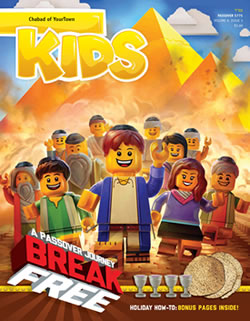
Download the Passover Kids Magazine (PDF)
Enter your Information
Note: Please fill out this form after Passover.
My child completed the missions checked off above. Please enter him/her into the raffle.
Please add me to your mailing list.
© Copyright 2015, all rights reserved.
Chabad.org Magazine - Editor: Yanki Tauber____________________________
No comments:
Post a Comment